SPECIAL TOPIC—Superconductivity and its Applications
SPECIAL TOPIC—Superconductivity and its applications
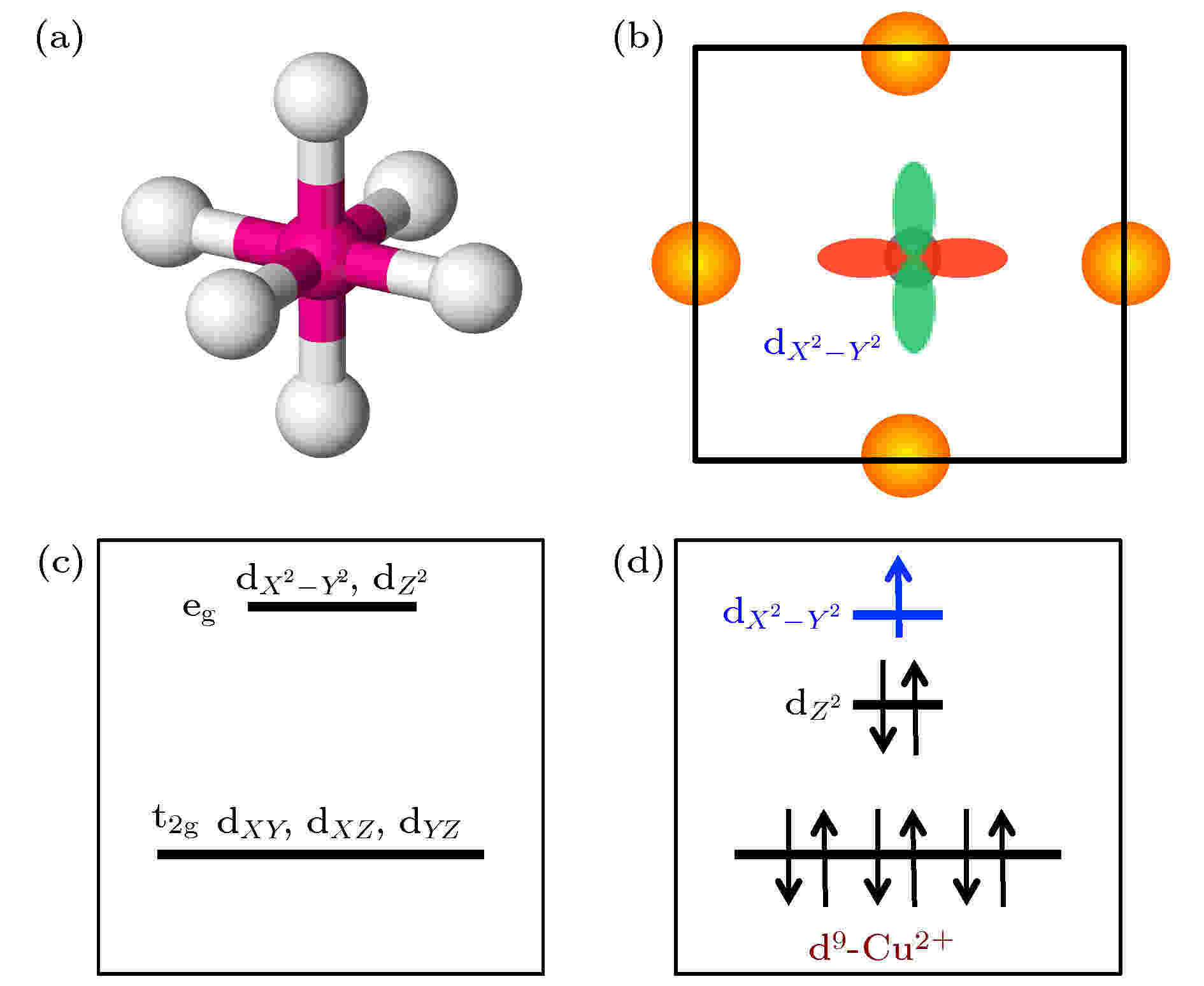
EDITOR'S SUGGESTION
2021, 70 (1): 017101.
doi:10.7498/aps.70.20202122
Abstract +
Based on the common properties exhibited in both cuprates and iron-based high temperature superconductors, we have recently proposed the “gene” concept for unconventional high temperature superconductors: those d-orbitals of transition metal elements with the strongest in-plane bonding to anion p-orbitals must be isolated near Fermi energy. Here we summarized recent progress in this research direction and discussed several electronic environments that meet the “gene” condition. We also discussed the challenge and the possibility in finding new unconventional high temperature superconductors.
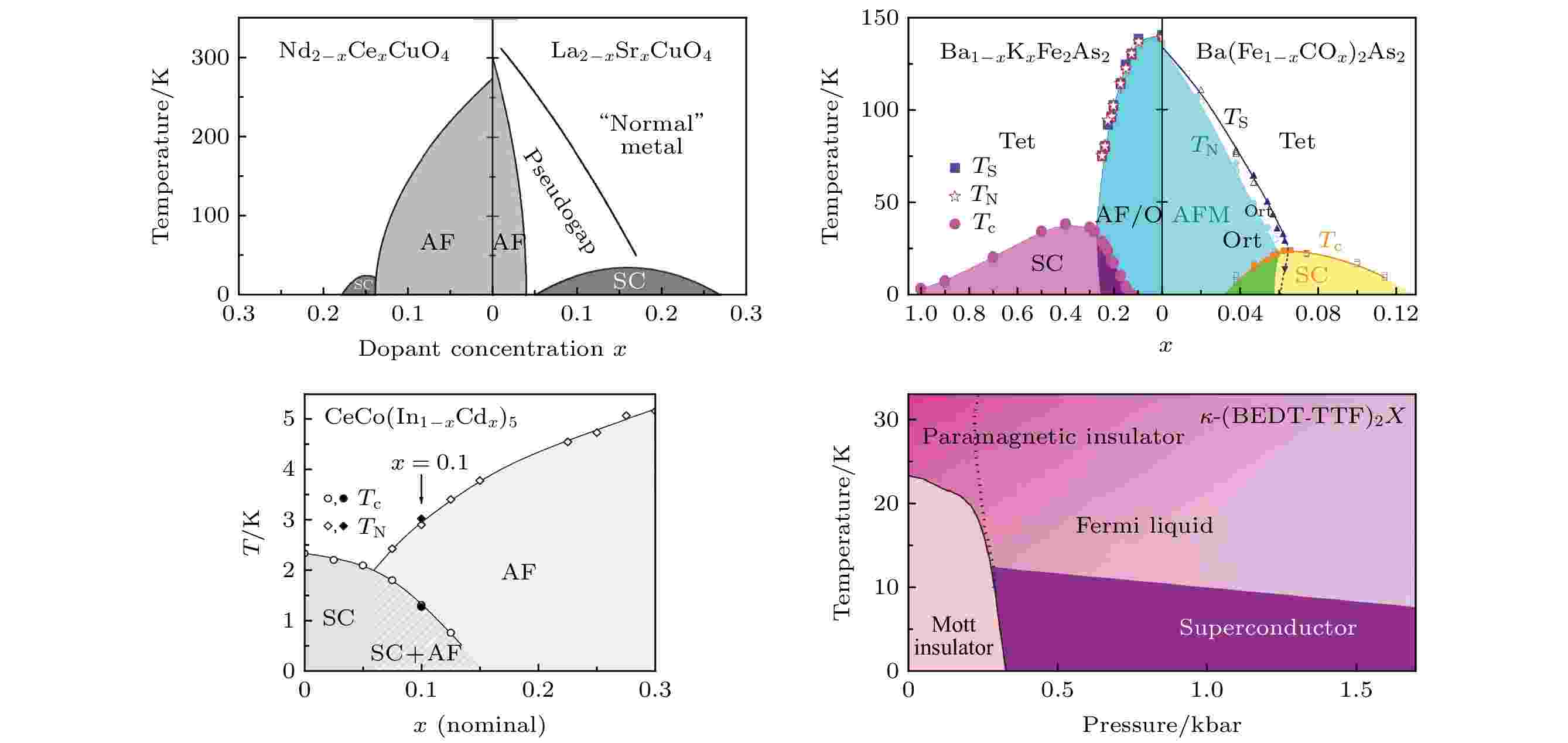
EDITOR'S SUGGESTION
2021, 70 (1): 017408.
doi:10.7498/aps.70.20202180
Abstract +
High-Tccuprates, iron-based superconductors, heavy-fermion superconductors andκ-type layered organic superconductors share some common features − the proximity of the superconducting state to the magnetic ordered state and the non-s-wave superconducting pairing function. It is generally believed that the Cooper pairings in these unconventional superconductors are mediated by spin fluctuations. In this paper, we present a brief overview on the spin dynamics and unconventional pairing, focusing on high-Tccuprates and iron-based superconductors. In particular, we will overview the properties of the neutron spin resonance and its possible origin, the pairing mechanism in Hubbard model within the weak-coupling framework and its application to the aforesaid unconventional superconductors. We point out that the interplay between magnetism and superconductivity is still an area of active research.
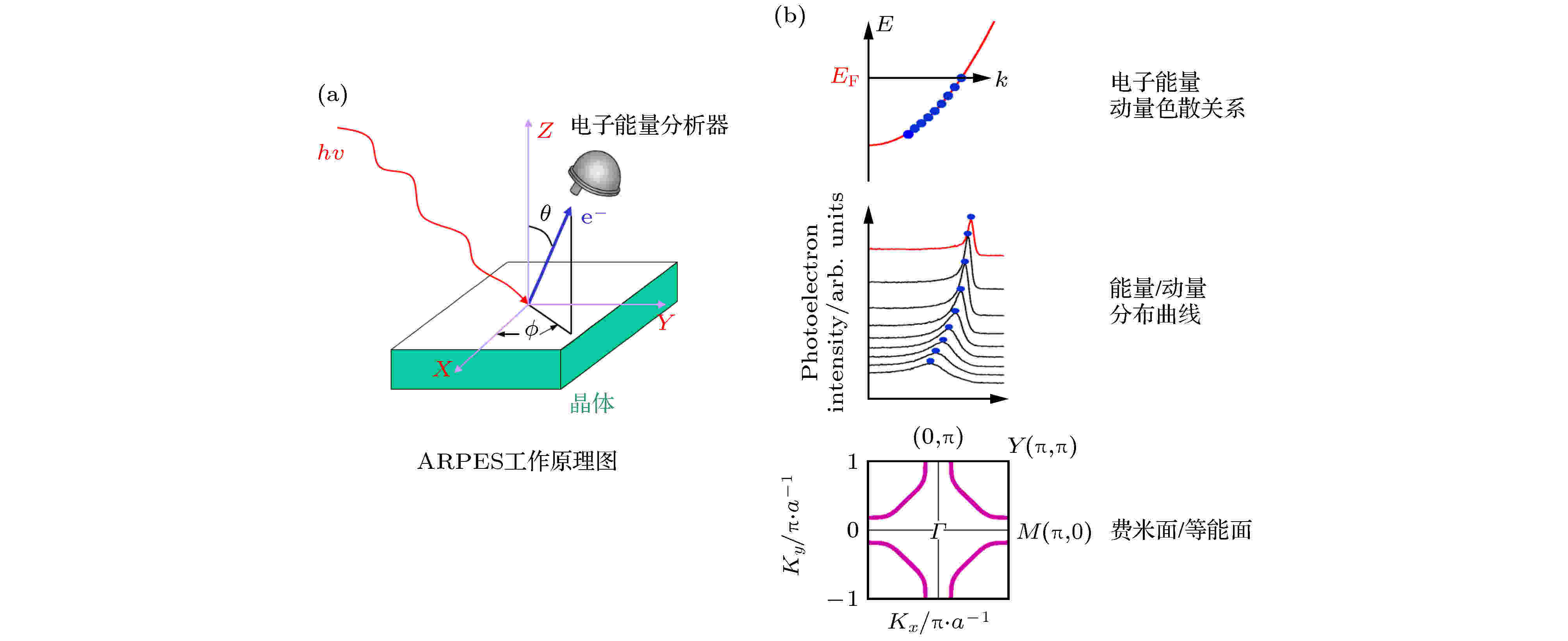
EDITOR'S SUGGESTION
2021, 70 (1): 017406.
doi:10.7498/aps.70.20201913
Abstract +
Superconductivity represents a magic macroscopic quantum phenomenon. There have been two major categories of superconductors: the conventional superconductors represented by metals or alloys; and the unconventional superconductors represented by cuprates and iron-based high-temperature superconductors. While the superconductivity mechanism of the conventional superconductors is successfully addressed by the BCS theory of superconductivity, no consensus has been reached in understanding the high temperature superconductivity mechanism for more than 30 years, which has become one of the most prominent issues in condensed matter physics. Revealing the microscopic electronic structure of unconventional superconductors is the prerequisite and foundation in understanding their superconductivity. Angle resolved photoelectron spectroscopy (ARPES) plays an important role in the study of unconventional superconductors because it can directly measure the electronic structure of materials. In this paper, our recent progress in the ARPES study of electronic structure and superconductivity mechanism of high temperature cuprate superconductors and iron-based superconductors is reviewed. It mainly includes the electronic structure of the parent compound, the non-Fermi liquid behavior in the normal state, the band and gap structure of the superconducting state, and the many-body interactions both in the normal and superconducting states. These results will provide important information in understanding the superconductivity mechanism of Cu-based and Fe-based superconductors.
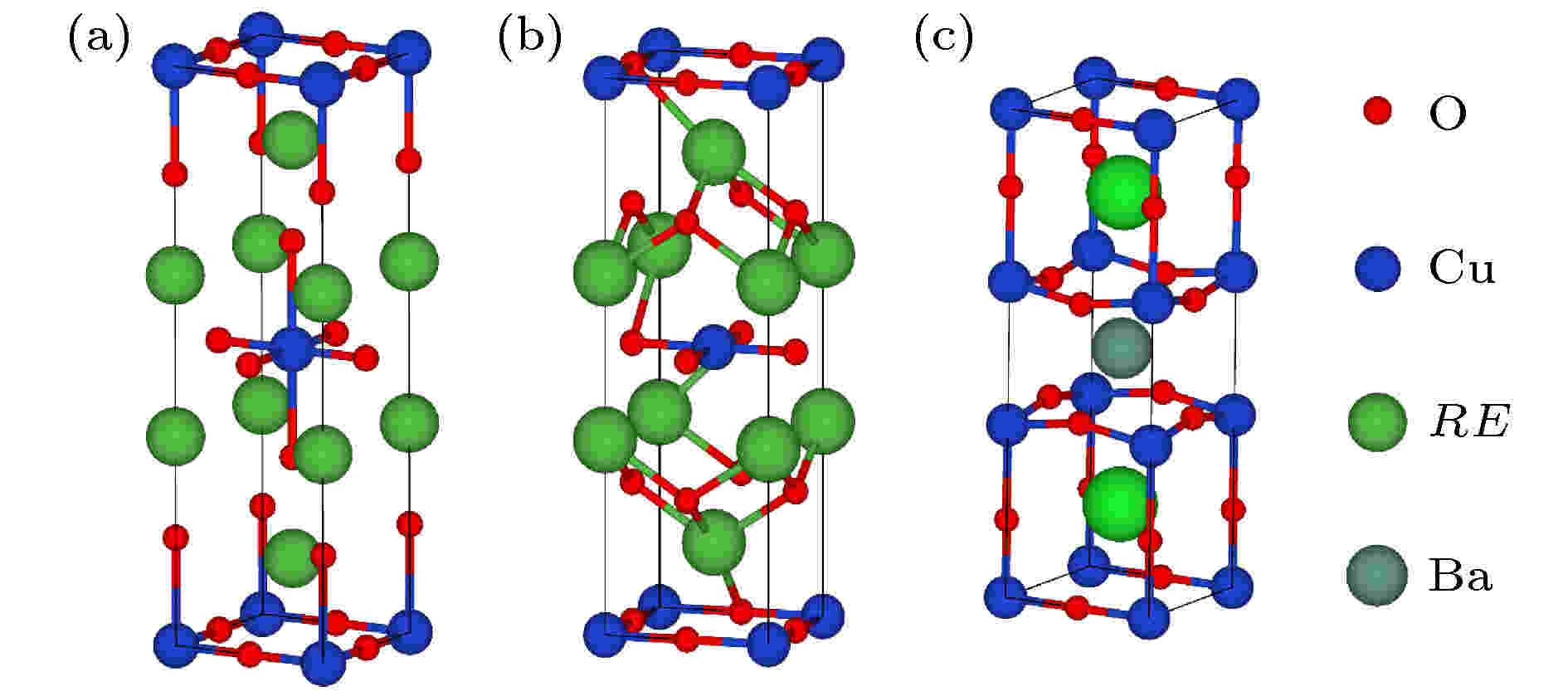
EDITOR'S SUGGESTION
2021, 70 (1): 017403.
doi:10.7498/aps.70.20202102
Abstract +
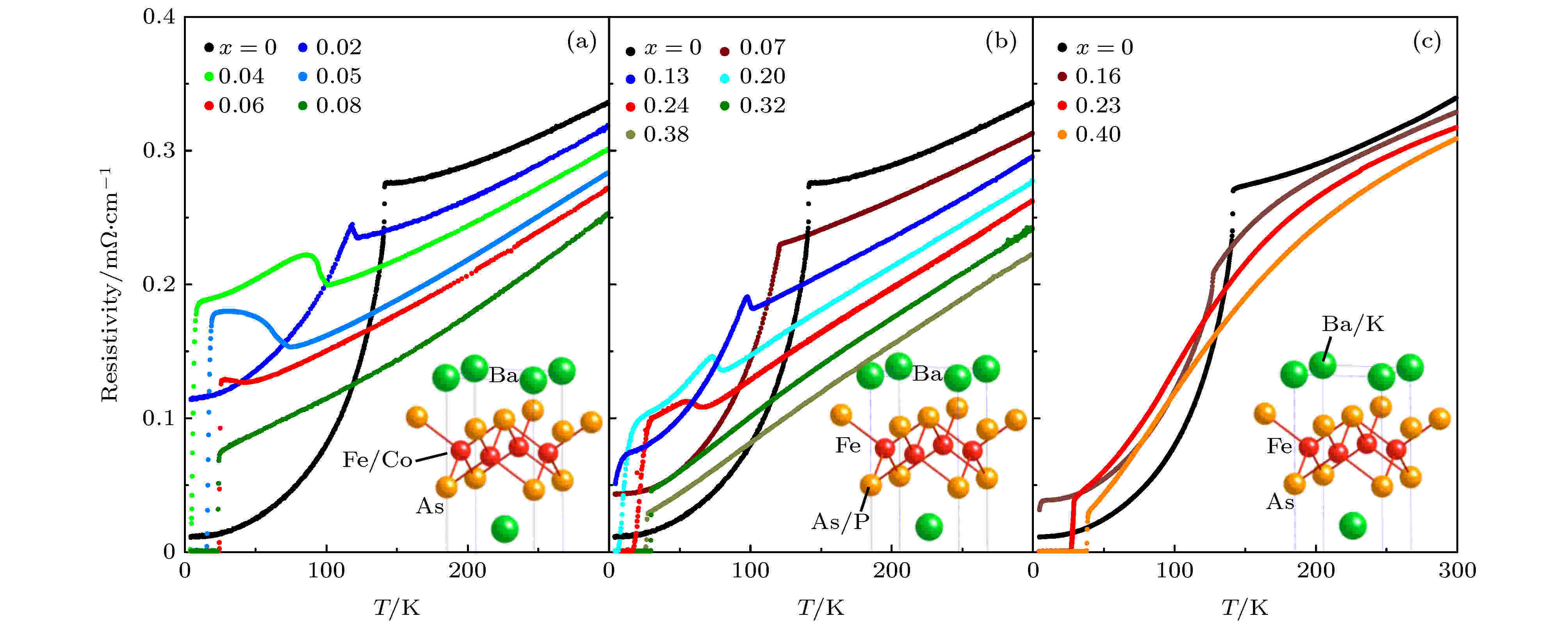
EDITOR'S SUGGESTION
2021, 70 (1): 017404.
doi:10.7498/aps.70.20201836
Abstract +
There are a variety of order states in iron-based pnictides, such as electronic nematic phase, spin density wave, and so on, which leads to plenty of novel physical phenomena. The measurements of transport properties can provide extremely useful information for understanding of the low-energy excitations of iron-based superconductors. Due to the multi-band electronic structure in iron-based pnictides, the temperature dependence of resistivity and Hall coefficient varies with different systems, however, there are no evidence for the pseudo-gap opening in the normal state which is a common feature in underdoped high-
$T_{\rm{c}}$
cuprates. In the hole-doped iron-based superconductors, the Hall coefficient changes its sign in low temperatures, and meanwhile the resistivity shows a broad hump in the same temperature range. Such a behavior is proposed as a crossover from incoherent to coherent transport. The Seebeck coefficients of iron-based superconductors also show remarkable differences from the cuprates. In iron-based superconductors, the absolute value of Seebeck coefficients in the normal state becomes the largest at the optimally doping point with highest
$T_{\rm{c}}$
, which is probably related to the strong inter-band scattering. The Nernst effect in the normal state of iron-based superconductors indicates that superconducting phase fluctuations is not obvious above
$T_{\rm{c}}$
, which is also significantly different from the cuprates. These unusual thermoelectric properties observed in iron-based superconductors have not been observed in the nickel-based pnictide superconductors with the analogous structure, i.e., LaNiAsO, and the nickel-based superconductors behave more like a usual metal. All these results above illustrate that these unusual transport properties of iron-based superconductors are inherently associated with their high temperature superconductivity, and these factors should be taken into account in the theory on its superconducting mechanism.
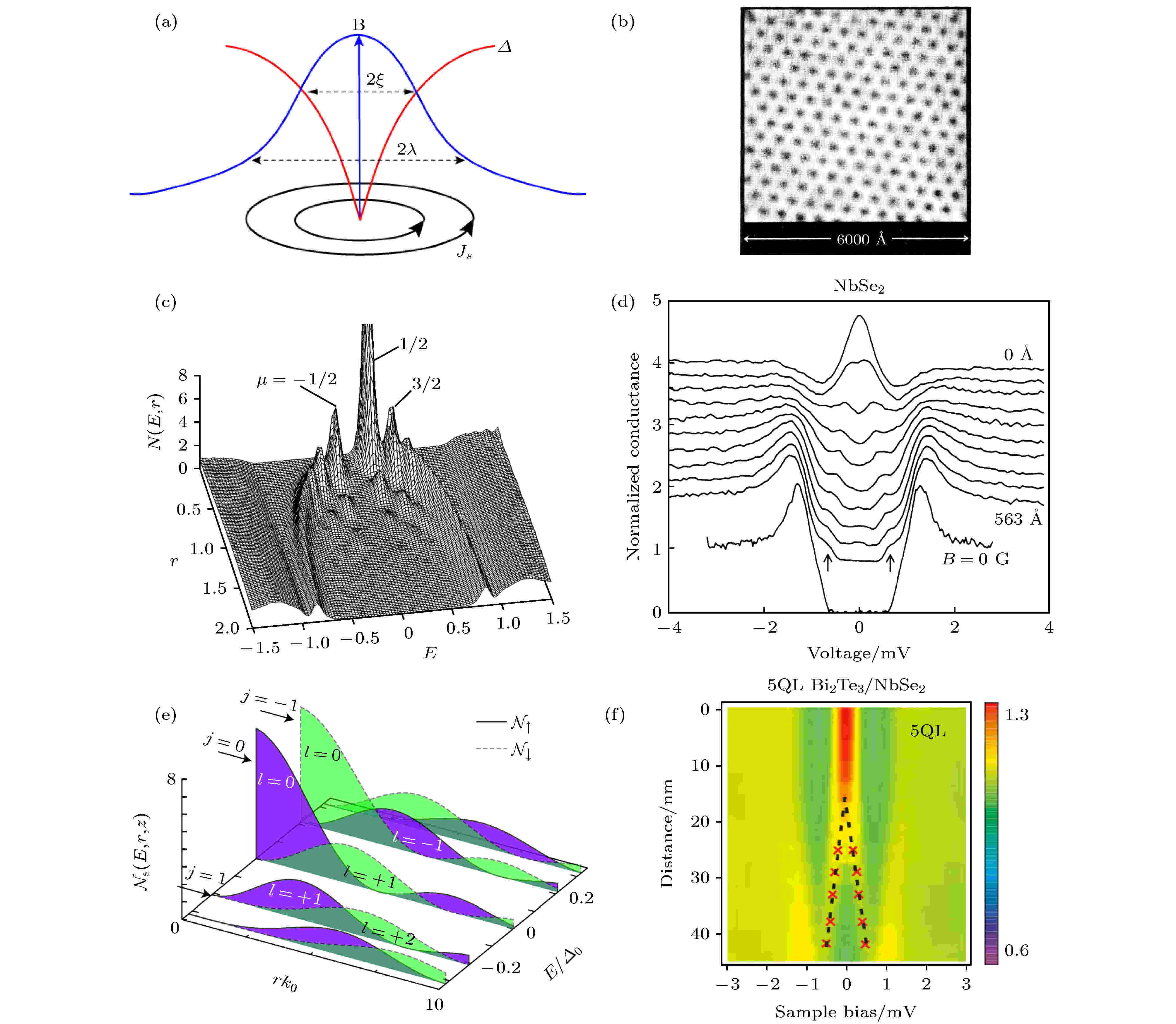
EDITOR'S SUGGESTION
2021, 70 (1): 017401.
doi:10.7498/aps.70.20201673
Abstract +
As a novel quantum state in condensed matter physics, Majorana zero mode has become a popular research topic at present because of its potential value in topological quantum computing. Theory predicts that Majorana zero mode appears in the vortex core of the topological superconductor as a unique bound state. However, due to various factors such as the existence of conventional low energy bound states or impurity states, it is difficult to identify the Majorana zero mode and to put it into the specific applications. Nowadays, it is still urgent to find a suitable topological superconducting system and identify the clean Majorana zero mode in experiment. In this paper, we study the vortex states of electron-doped iron-selenium-based superconductors (Li, Fe)OHFeSe and single-layer FeSe/SrTiO3with extremely high energy resolution STM. There exists a robust and clean Majorana zero mode in the free vortex core of (Li, Fe)OHFeSe, which has the quantized conductance. As for single-layer FeSe/SrTiO3film, it has only conventional Caroli-de Gennes-Matricon (CdGM) bound states without zero energy mode. These experimental results provide a suitable platform for further studying the physical properties of Majorana zero mode, and also shed light on the source of topological superconductivity in iron-based superconductors.
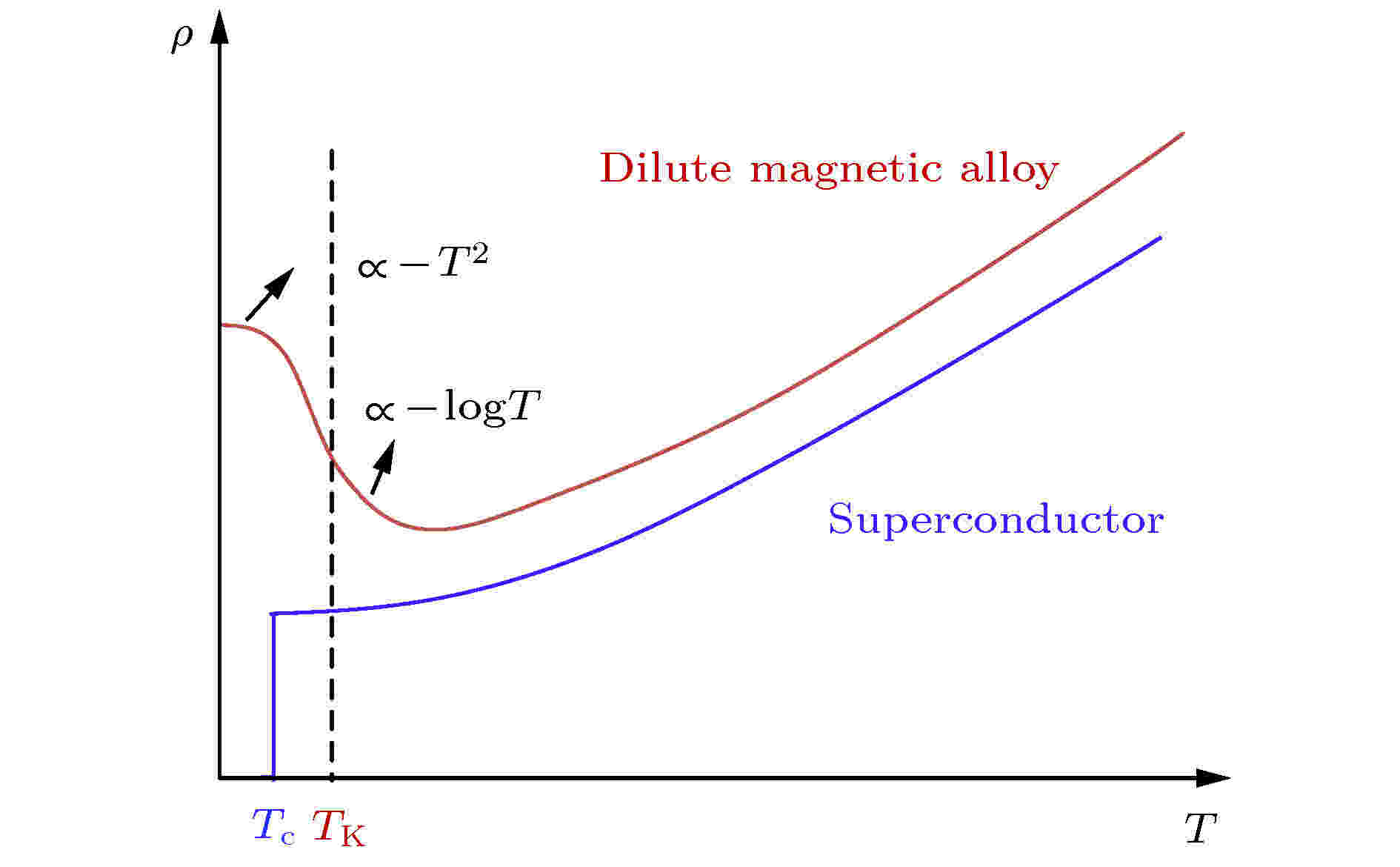
EDITOR'S SUGGESTION
2021, 70 (1): 017402.
doi:10.7498/aps.70.20201418
Abstract +
Heavy fermion superconductors belong to a special class of strongly correlated systems and unconventional superconductors. The emergence of superconductivity in these materials is closely associated with the presence of quantum critical fluctuations. Heavy fermion superconductors of different structures often exhibit distinct competing orders and superconducting phase diagrams, implying sensitive dependence of their electronic structures and pairing mechanism on the crystal symmetry. Here we give a brief introduction on recent theoretical and experimental progress in several different material families. We develop a new phenomenological framework of superconductivity combining the Eliashberg theory, a phenomenological form of quantum critical fluctuations, and strongly correlated band structure calculations for real materials. Our theory provides a unified way for systematic understanding of various heavy fermion superconductors.
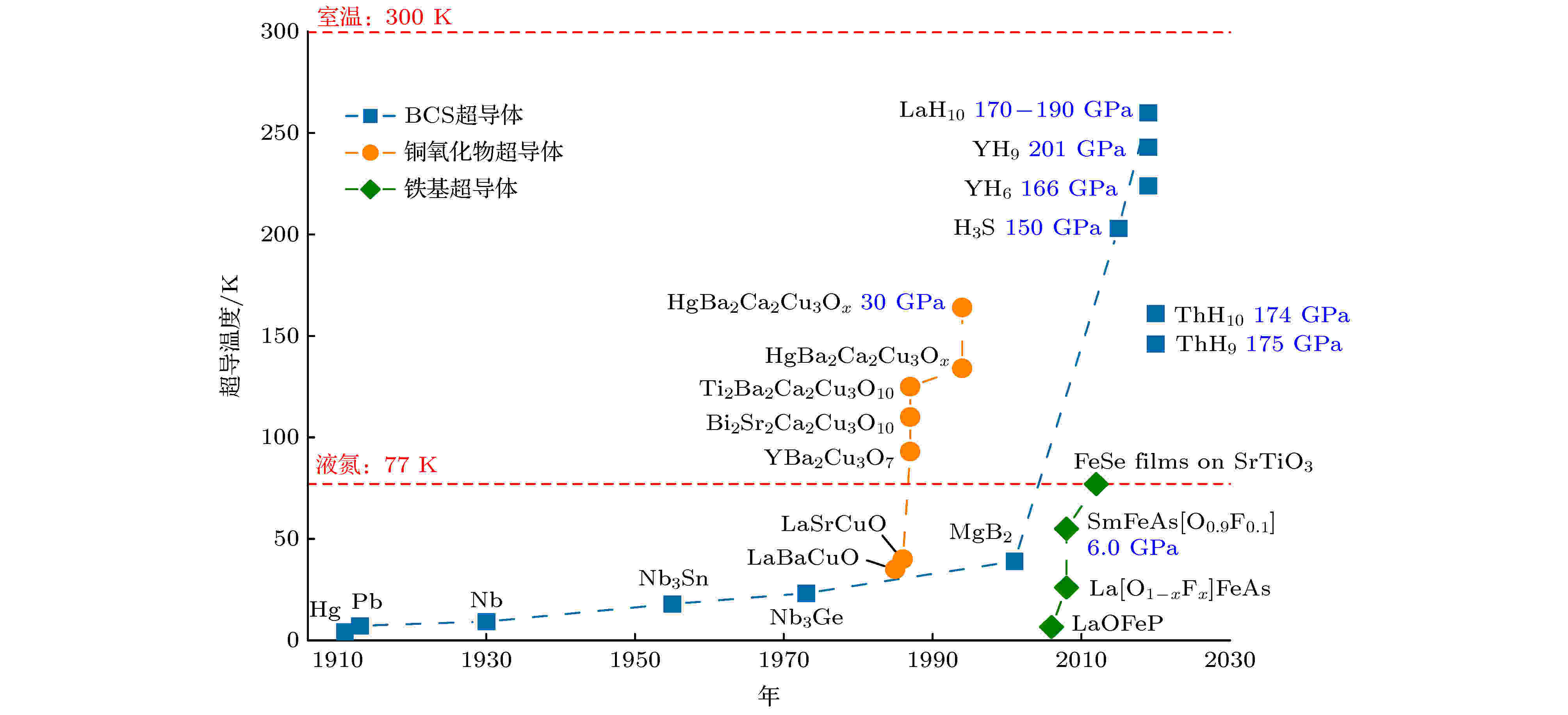
EDITOR'S SUGGESTION
2021, 70 (1): 017407.
doi:10.7498/aps.70.20202189
Abstract +
In recent years, hydrogen-rich compounds under extremely high pressure have become the hot target materials for high-temperature superconductors. At present, two landmark progresses have been made in this field. Covalent H3S hydrogen-rich superconductors (Tc= 200 K) and ionic hydrogen-rich superconductors with hydrogen-cage structure, such as LaH10(Tc= 260 K, –13 ℃), YH6and YH9, have been successively synthesized, setting a new record of superconducting temperature. These studies have given rise to the hope of discovering room-temperature superconductors in hydrogen-rich compounds under high pressure. This paper focuses on the progress of hydrogen-rich superconductors with high critical temperature under high pressure, discusses the physical mechanism of high-temperature superconductivity in hydrogen-rich compounds, provide an outlook on the possibility of discovering room-temperature superconductors in hydrogen-rich compounds in the future, and offer the candidate system for high superconductivity in multiple hydrogen-rich compounds.
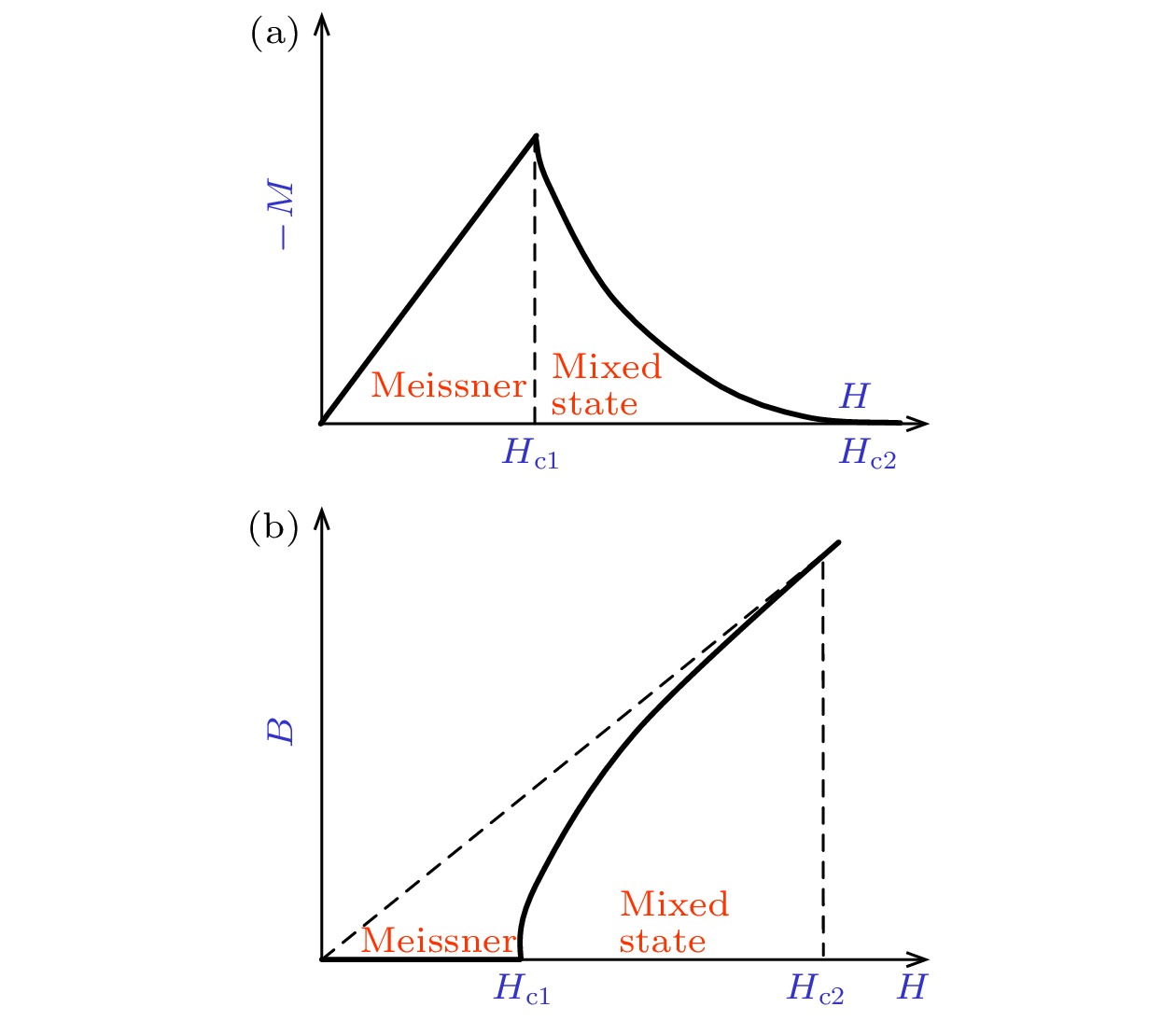
EDITOR'S SUGGESTION
2021, 70 (1): 017405.
doi:10.7498/aps.70.20201881
Abstract +
Superconductivity is achieved through macroscopic phase coherence; the charge carriers are Cooper pairs. In absence of an external magnetic field and applied current, the behavior of these Cooper pairs can be described by a single wave function
$ \psi = {\psi _{\rm{0}}}{e^{i\varphi }}$
, and the phase is uniform over the space. When applying an external field but still below a certain threshold, a screening current will be established at the surface, which prohibits the entering of magnetic field, that is so-called Meissner effect. When the external field is larger than this threshold, the magnetic flux will penetrate into the sample, forming the interface of superconducting and normal state regions. According to the sign of this interface energy, we can categorize superconductors into type-I (positive interface energy) and type-II (negative interface energy). Most superconductors found so far are type-II in nature. Due to the negative interface energy in type-II superconductors, the penetrated magnetic flux will separate into the smallest bundle, namely the quantum flux line, with a quantized flux
${\varPhi _0} = h/2e$
(his the Planck constant andeis the charge of an electron). There are weak repulsive interactions among these vortices, thus usually they will form a lattice, called mixed state. When applying a current, a Lorentz force will exert on the flux lines (vortices) and will make them to move, this will induce energy dissipation and the appreciable feature of zero resistance of a superconductor will be lost. By introducing some defects, impurities or dislocations into the system, it is possible to pin down these vortices and restore the state of zero resistance. The study concerning vortex pinning and dynamics is very important, which helps not only the understanding of fundamental physics, but also to the high power application of type-II superconductors. This paper gives a brief introduction to the vortex dynamics of type-II superconductors.
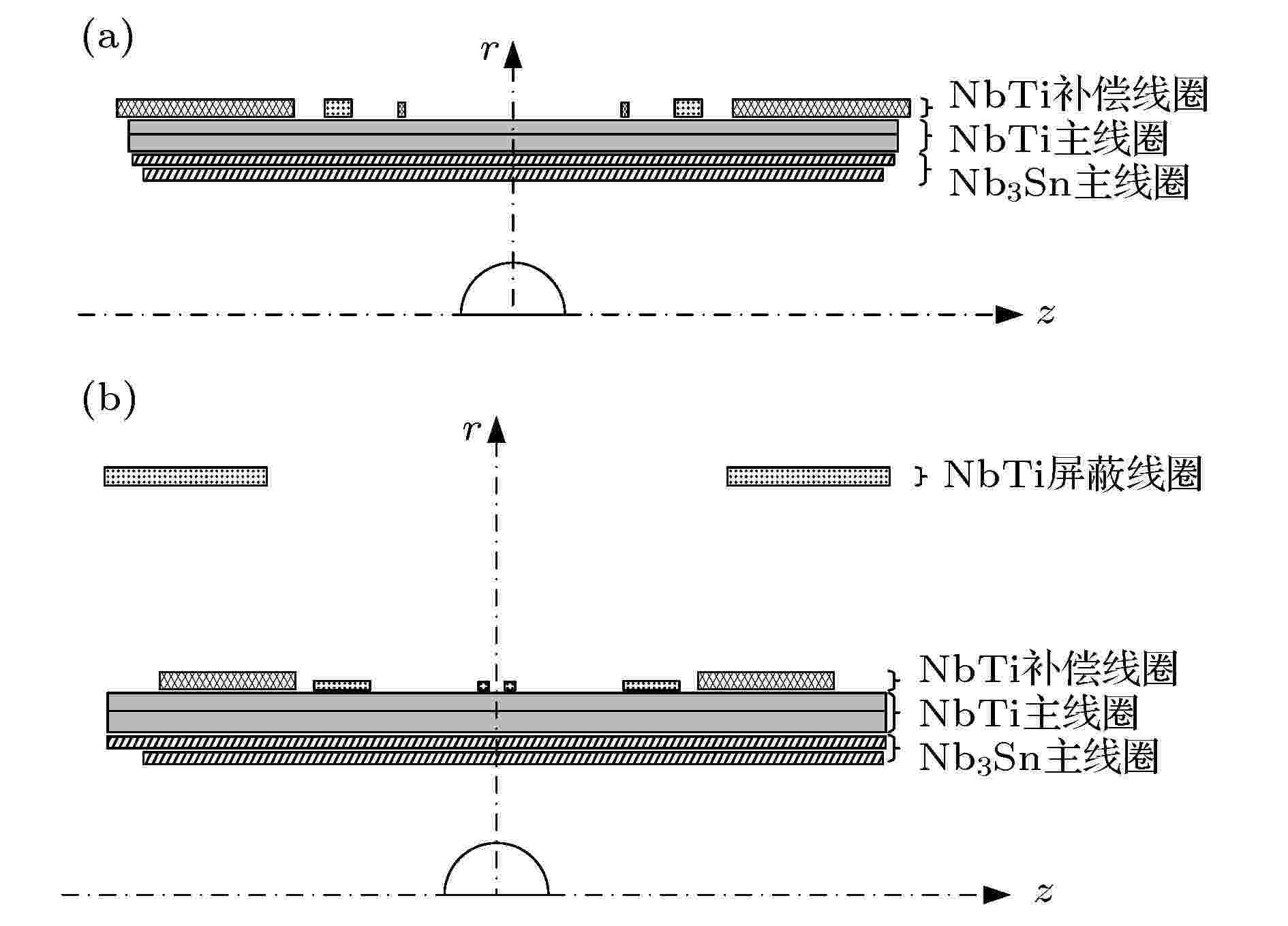
EDITOR'S SUGGESTION
2021, 70 (1): 018401.
doi:10.7498/aps.70.20202042
Abstract +
This paper presents a brief review of the development trend of superconducting magnets in large scale applications towards high magnetic fields, depending on and pushing the Nb3Sn wire technics' continuous improvement. The focus is on analysis of the technology challenges of 14 T whole-body superconducting magnets. Using the Bonze Nb3Sn wires and on the base of a combination design of Nb3Sn and NbTi coils, an electromagnetic conception design of a 14 T whole-body MRI magnet is presented, and the thermal stability and quench protection are analyzed by simulations. The critical issues on stress, joints as well as shimming of 14 T whole-body superconducting magnets are also discussed. According to the results, this paper believes: 1) Nb3Sn wires are of the first important issue for 14 T whole-body superconducting magnets—the Bonze Nb3Sn wire is of the best choice but the performance specifications of the current products need to be improved further to match the requirements; 2) quench protection of 14 T whole-body superconducting magnets is one of the most complicated technics that covers design of the copper to superconductor (Cu/SC) ratio, coordination of the operating current and coil inductances, subdivisions of passive protection circuits and quench triggering control of active protection, as well as the stray field limitation during the transient process.
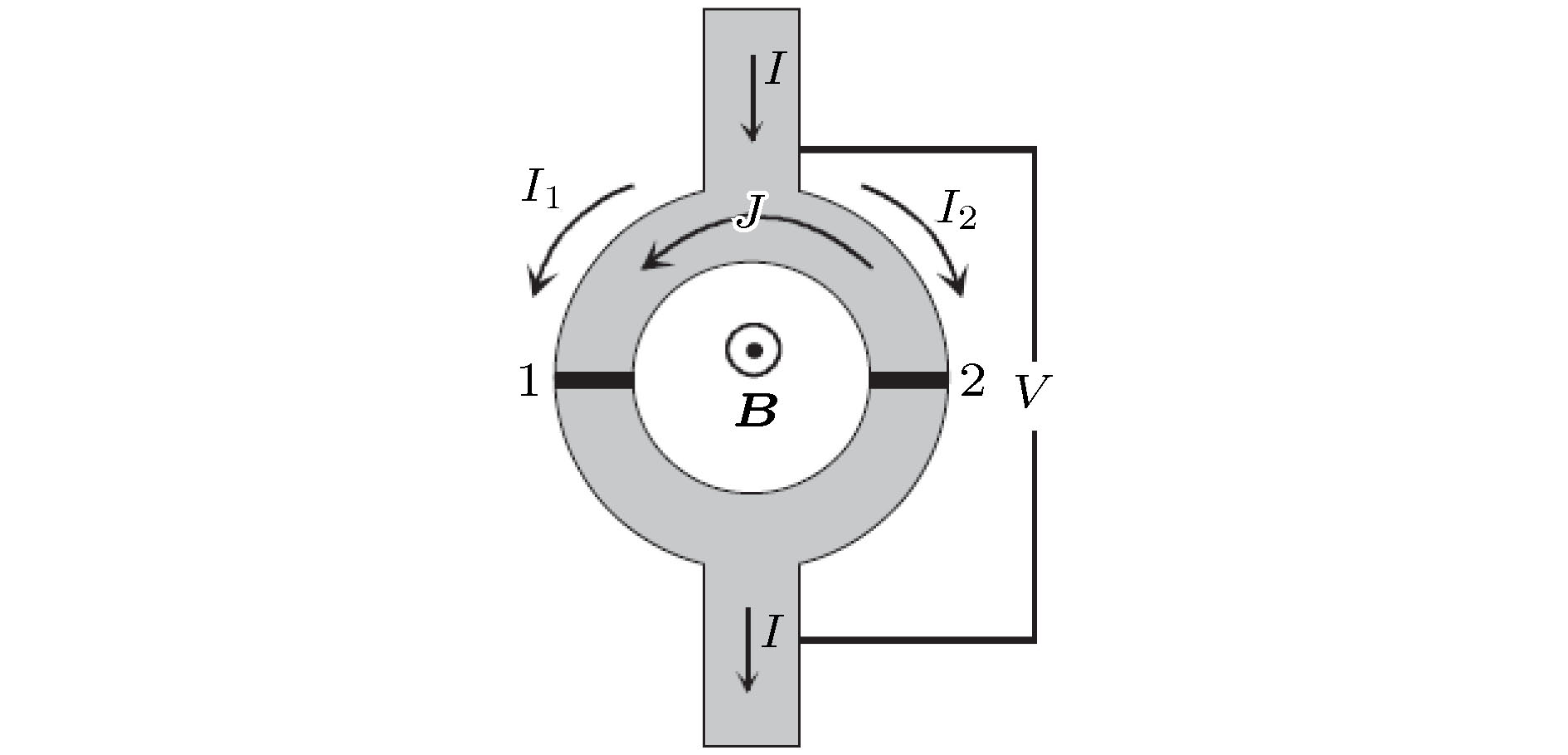
EDITOR'S SUGGESTION
2021, 70 (1): 018502.
doi:10.7498/aps.70.20202131
Abstract +
Superconductivity is a macroscopic quantum phenomenon. Flux quantization and the Josephson effect are two physical phenomena which can best reflect the macroscopic quantum properties. Superconducting quantum interference device (SQUID) is one type of superconducting devices which uses these two characteristics. SQUID devices are widely used in the sensitive detection of magnetic signals. This paper briefly introduces the background and recent developments of low temperature superconductor and high temperature superconductor SQUID devices.
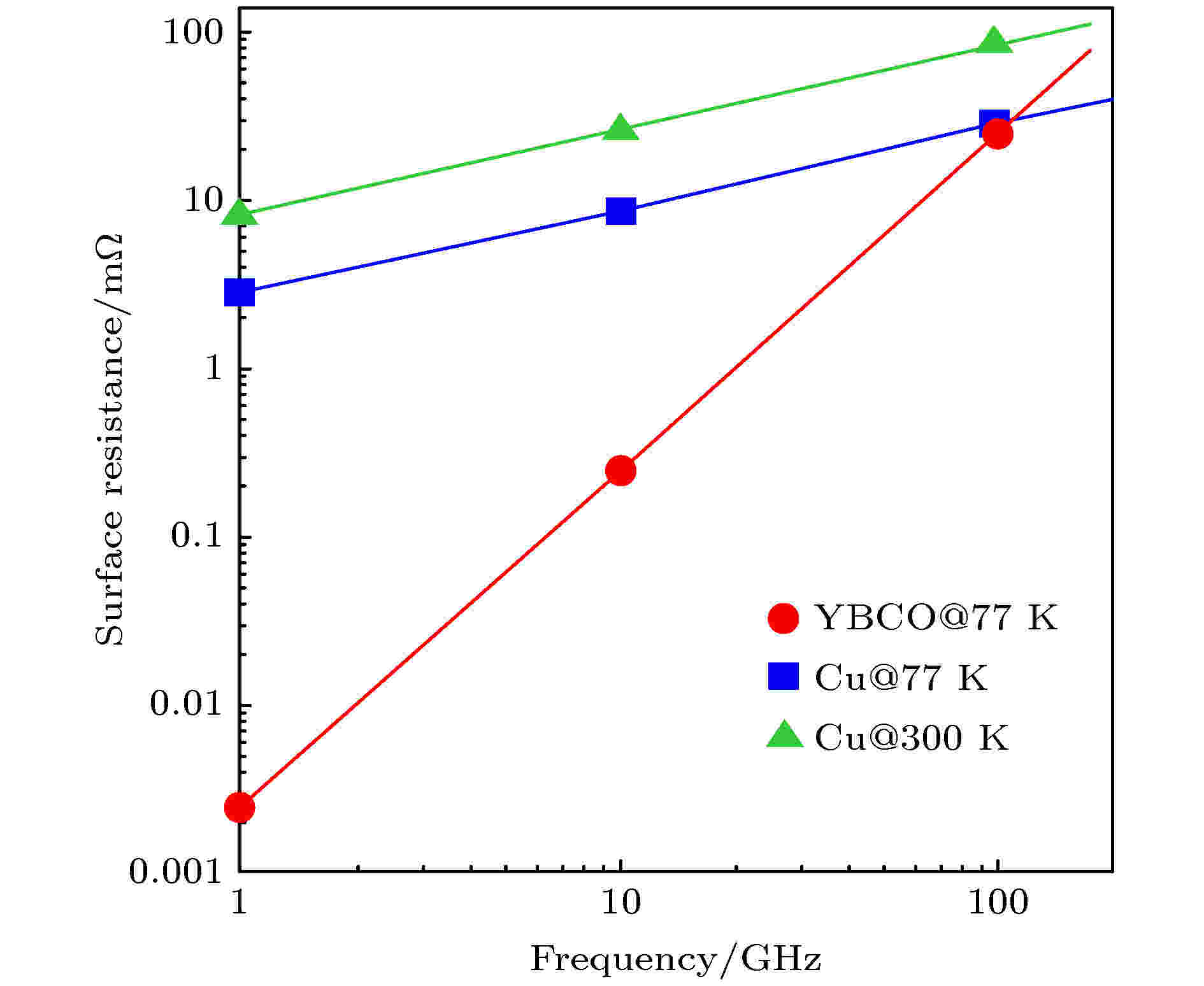
EDITOR'S SUGGESTION
2021, 70 (1): 018501.
doi:10.7498/aps.70.20202121
Abstract +
It has been nearly 110 years since the discovery of superconductors, and more than 30 years since the discovery of high temperature superconductors (HTS). Great progress has been made in the application of superconducting electronics in the last two decades. HTS microwave devices have shown much higher perfomance than the traditional ones and have found their ways to the industry applications in mobile communication, radar, and special communication applications. Owing to the ultrahigh sensitivity to magnetic fields and currents, superconducting quantum interference devices (SQUIDs) have been used as the irresplacible sensors in geological surveying, magnetic resonanc imaging, biomagnetic imaging, and other areas. The sensitivity of superconducting radiation detectors such as superconducting SIS mixer, superconducting hot electron bolometer, superconducting transition edge sensor, superconducting nanowire single photon detector, and superconducting microwave kinetic inductance detector are near the quantum limitation. They are now key technology in geophysics, astrophysics, quantum information science, biomedicine, and so on. Superconducting Josephson parametric amplifier has become a key element for superconducting quantum computing. Superconducting integrated circuit has been included in the international roadmap for devices and systems, and shows that having the potential to become one of the mainstreams for post-Moore information processing technology. In metrology, superconducting Josephson effect and Josephson junction array devices have been widely used in the redefinition of quantum voltage reference and basic units of the International system of Units. Superconducting electronics plays an important role in the current quantum information technology boom, which in turn promotes the development of superconducting electronics. This review will brief introduce the research and application of superconducting electronics in China in recent years.
GENERAL

EDITOR'S SUGGESTION
2021, 70 (1): 010201.
doi:10.7498/aps.70.20201371
Abstract +
Background:The coronavirus disease 2019 (COVID-19) has raged more than 10 months and it has become a major public health concern. It is necessary to account for the intrinsic mechanisms and reveal the transmission pattern.Method:We collect detailed information of 944 COVID-19 cases in Guangdong province from January 23rd to February 16th. According to the age-structured characteristics, the population is divided into four groups such as child group (0–5 years old), adolescent group (6–19 years old), young and middle-aged group (20–64 years old), elderly group (65 and over years old). Coupling with different age-structured contact patterns, we establish a discrete age-structured COVID-19 model, obtain the basic reproduction number and final size. By Markov Chain Monte Carlo numerical method (MCMC), we identify the model parameters, fit the cumulative cases, calculate eradiation time of disease, infection peak and the peak arrival time, etc.Results:We found that the most infected people are the young and middle-aged individuals; Compared with household quarantine measure, the peak value of hospitalizations among young and middle-aged group in community mode will increase of 41%, and the peak will delay two weeks. By analyzing the proportions of the final sizes associated age groups, it is found that the elderly have a higher susceptibility, while the adolescents have a lower susceptibility. Under the household quarantine measure, if infected individuals have been confirmed in time of half a day, the peak size of hospitalizations will be further reduced, and the peak hospitalization will advance one week. The model reveals social contact patterns for impacting on COVID-19 transmission, and evaluates the effectiveness of household quarantine.
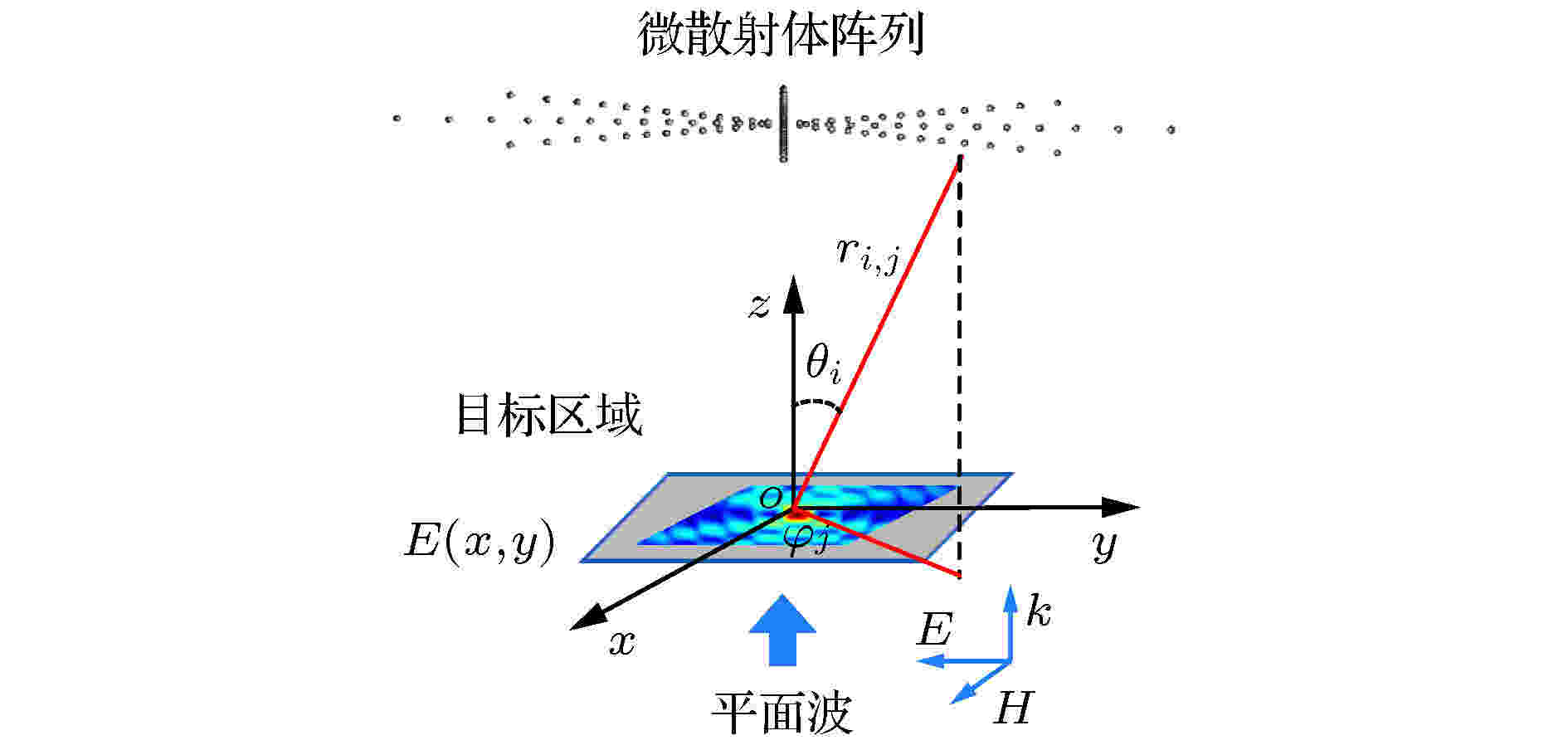
2021, 70 (1): 010202.
doi:10.7498/aps.70.20200825
Abstract +
It is a novel and interesting idea to inversely design the scattering structure with the desired scattering field intensity distribution in a given target area as the known information. The inverse design method proposed in this paper does not need to be optimized, and the spatial distribution and dielectric constant distribution of the micro-scatterer array can be quickly analytically calculated according to the desired scattering field intensity in the target area. First, based on the spatial Fourier transform and angular spectrum transformation, the plane wave sources required in all directions are inversely obtained from the electric field intensity distribution required in the target area. Then, based on the theory of induced source, a method of irradiating the array of all-dielectric micro-scatterers with incident electromagnetic field to generate the required plane wave source is proposed. The scattering fields generated by these micro-scatterers will be superimposed on the target area to achieve the desired scattering field strength intensity. Finally, according to the proposed inverse design theory model, a specific three-dimensional (3D) design is carried out. In the 3D example, we study the scattering field intensity distribution of the point-focused shape of the square surface target area, and show an all-dielectric micro-sphere distribution design. Its spatial distribution and permittivity distribution are both obtained through the rapid analytical calculation of the desired scattered field intensity shape in the target area. Finally, based on the principle of linear superposition, we quickly and easily generate the complex shapes of “I”, “T”, and “X” in the target area. The satisfactory results of full-wave simulation show that the proposed inverse design method is effective and feasible.
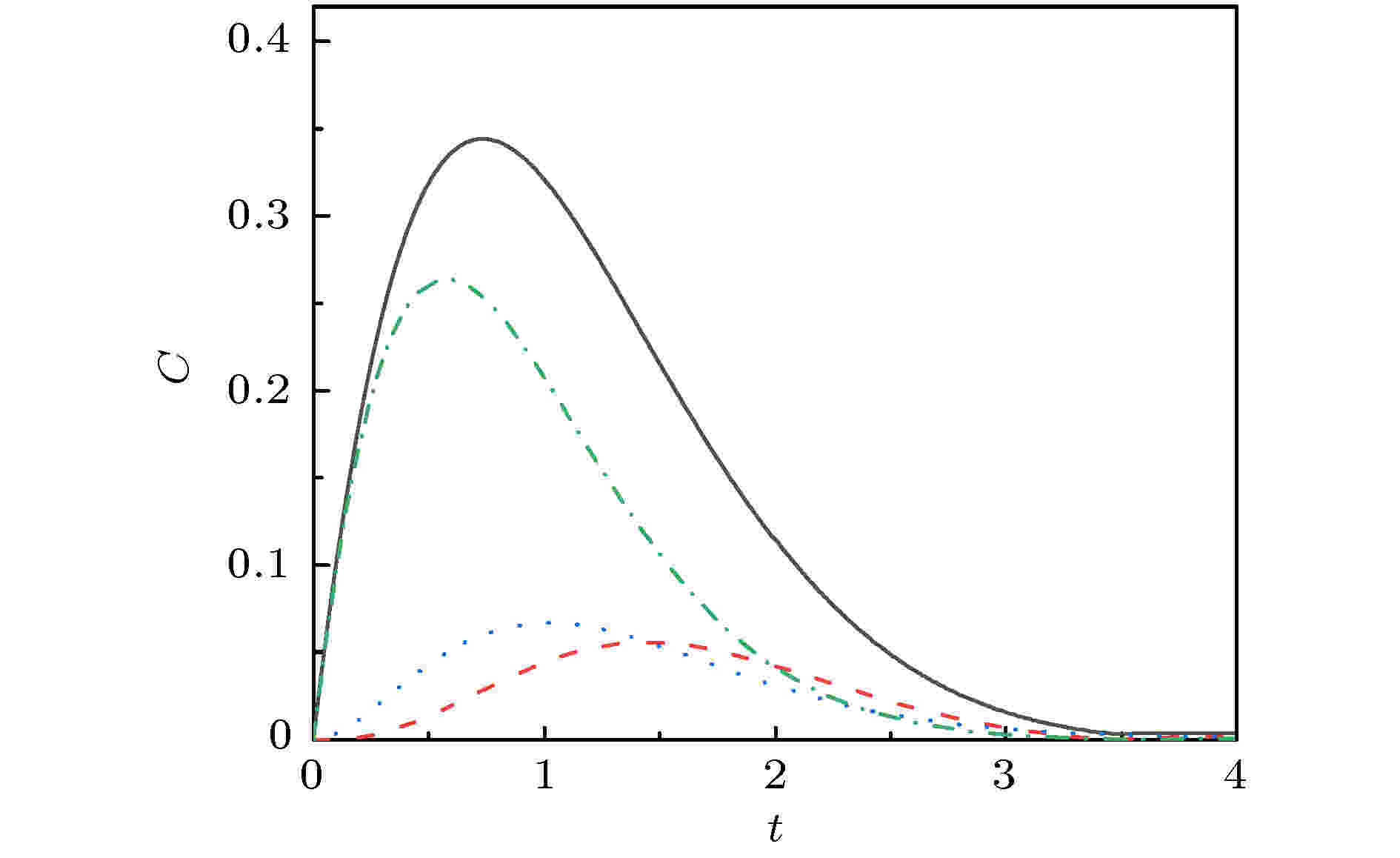
2021, 70 (1): 010301.
doi:10.7498/aps.70.20201199
Abstract +
The time evolution of multipartite quantum coherence is studied in a three-body spin system with an asymmetric interaction. Thel1norm measurement is used to estimate the degree of quantum coherence in the spin system. The decoherence of all components of quantum coherence in the three-body spin system is analyzed by the exact diagnolization and numerical method based on quantum master equation. The environmental noise induced by the spontaneous decay can be simulated by the quantum amplitude damping model. It is found that the time evolution of quantum coherence component is closely related to the quantum property of the whole initial state. When the initial state is a separable pure one, the asymmetric interactions can conduce to the enhancement of the degree of multipartite quantum coherence in a short time interval. Under the influence of quantum noise, the degree of quantum coherence decreases gradually. We pay much attention to the spatial distribution of the degree of quantum coherence in a many-body system. The additivity relationship of bipartite component and tripartite coherence can exist if the initial state is chosen to be a Werner-like state. This kind of the coherence additivity between all bipartite components and global coherence can be extended to an arbitraryN-body Werner-like state. But this additivity relationship depends on thel1norm coherence measurement. Owing to the asymmetric interaction and noise, the degree of tripartite quantum coherence is more than the sum of all degrees of bipartite quantum coherence. The difference between the degree of tripartite coherence and the sum of all degrees of bipartite coherence is increased in a short time interval. The environmental noise can also suppress the difference in the coherence degree. The degree of the nearest neighboring bipartite coherence decreases more quickly than those of other bipartite coherences. The asymmetric interaction gives rise to the improvement in the degree of bipartite coherence and tripartite coherence. The coherence of the next-nearest neighboring two systems can be robust against the environmental noise. These results are helpful in preparing the multipartite quantum resources. We can utilize the system of coupled micro-cavities to realize the quantum spin system with controllable asymmetric interaction. In this way, the global coherence and bipartite coherence can be manipulated effectively by the quantum electromagnetic technology.
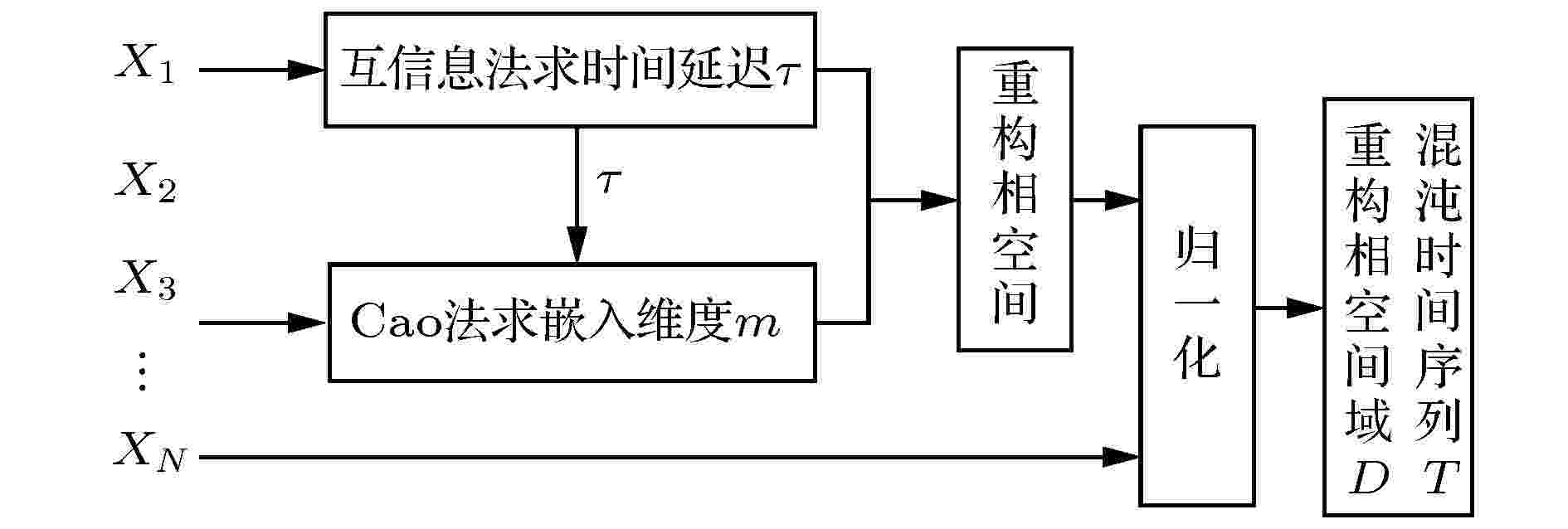
2021, 70 (1): 010501.
doi:10.7498/aps.70.20200899
Abstract +
Chaotic time series forecasting has been widely used in various domains, and the accurate predicting of the chaotic time series plays a critical role in many public events. Recently, various deep learning algorithms have been used to forecast chaotic time series and achieved good prediction performance. In order to improve the prediction accuracy of chaotic time series, a prediction model (Att-CNN-LSTM) is proposed based on hybrid neural network and attention mechanism. In this paper, the convolutional neural network (CNN) and long short-term memory (LSTM) are used to form a hybrid neural network. In addition, a attention model withsoftmaxactivation function is designed to extract the key features. Firstly, phase space reconstruction and data normalization are performed on a chaotic time series, then convolutional neural network (CNN) is used to extract the spatial features of the reconstructed phase space, then the features extracted by CNN are combined with the original chaotic time series, and in the long short-term memory network (LSTM) the combined vector is used to extract the temporal features. And then attention mechanism captures the key spatial-temporal features of chaotic time series. Finally, the prediction results are computed by using spatial-temporal features. To verify the prediction performance of the proposed hybrid model, it is used to predict the Logistic, Lorenz and sunspot chaotic time series. Four kinds of error criteria and model running times are used to evaluate the performance of predictive model. The proposed model is compared with hybrid CNN-LSTM model, the single CNN and LSTM network model and least squares support vector machine(LSSVM), and the experimental results show that the proposed hybrid model has a higher prediction accuracy.
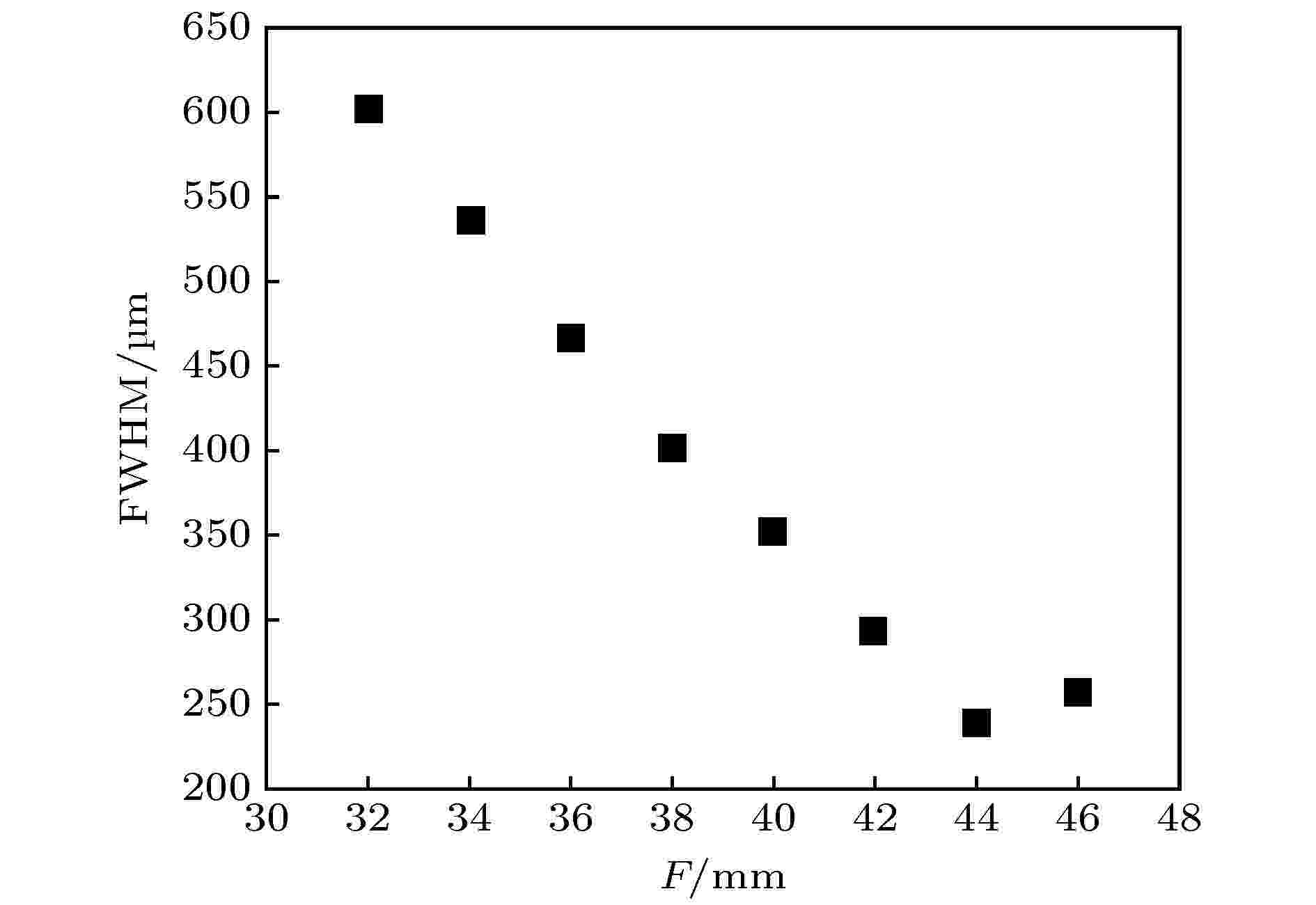
2021, 70 (1): 010701.
doi:10.7498/aps.70.20201228
Abstract +
In order to realize micron scale to millimeter scale phase structure analysis, as well as accurate phase structure analysis of surface uneven samples, X-ray diffractometer named Hawk-II, which can adaptively adjust the diameter of irradiated X-ray beam spot according to the diameter of internal tangential circle at the measured point, is developed by combining X-ray diffraction technology, CCD camera imaging technology and slightly-focusing ploycapillary X-ray control technology. The X-ray source system, six-dimensional linkage motion system, CCD camera, detection system and control system based on LabVIEW are the main components of the Hawk-II. Compared with the 3°–5° divergence of the conventional X-ray source, the divergence of the X-ray emitted by the slightly-focusing polycapillary X-ray optics is only about 0.15° and also the intensity within the beam spot range is dozens of times stronger. Therefore, the shift of peak position will not appear due to the pores, curvature or uneven surface of the sample, when Hawk-II is used to analyze the samples with irregular surface. The diffraction pattern of the uneven Ren Min Bi five-cent coin are collected in the Hawk-II and PANalytical X-Pert Pro MPD conventional X-ray diffractometer respectively. By comparing the analysis results, it is found that the diffraction peaks measured by the X-Pert Pro MPD are shifted seriously, with a maximum deviation angle of 0.52°. While the diffraction peaks detected by the Hawk-II are basically consistent with the data from the standard PDF card, which verifies the advantages of the analysis of irregular samples by the Hawk-II. In order to explore the difference between different beam spots used for analysis at the same point, red and green porcelain fired in Qing dynasty and GaAs-based Cu and Fe plated films are analyzed by the Hawk-II. It is found that when the samples are relatively uniform, the intensities of diffraction peaks of different beam spots are relatively close, while when the samples are not uniform, the diffraction peaks vary greatly. Especially, some microcrystalline phases can be detected only with large beam spots. In addition, to verify the adaptive functionality of the Hawk-II, a bronze from the Western Han Dynasty, with different rust spots on it, is tested. It is found that the Hawk-II can adjust the beam spot size according to the different corrosion points, making the irradiation area coincide with the area to be analysed and the phase structure detected more accurately. Therefore, the Hawk-II is a general purpose X-ray diffractometer, which has the analytical capability from micron scale to millimeter scale and the energy dispersive X-ray fluorescence analysis function. Moreover, it has the advantages of the accurate analysis of irregular samples, fast detection speed, simple operation, etc. Based on the above analysis, the Hawk-II will be widely used in different fields.
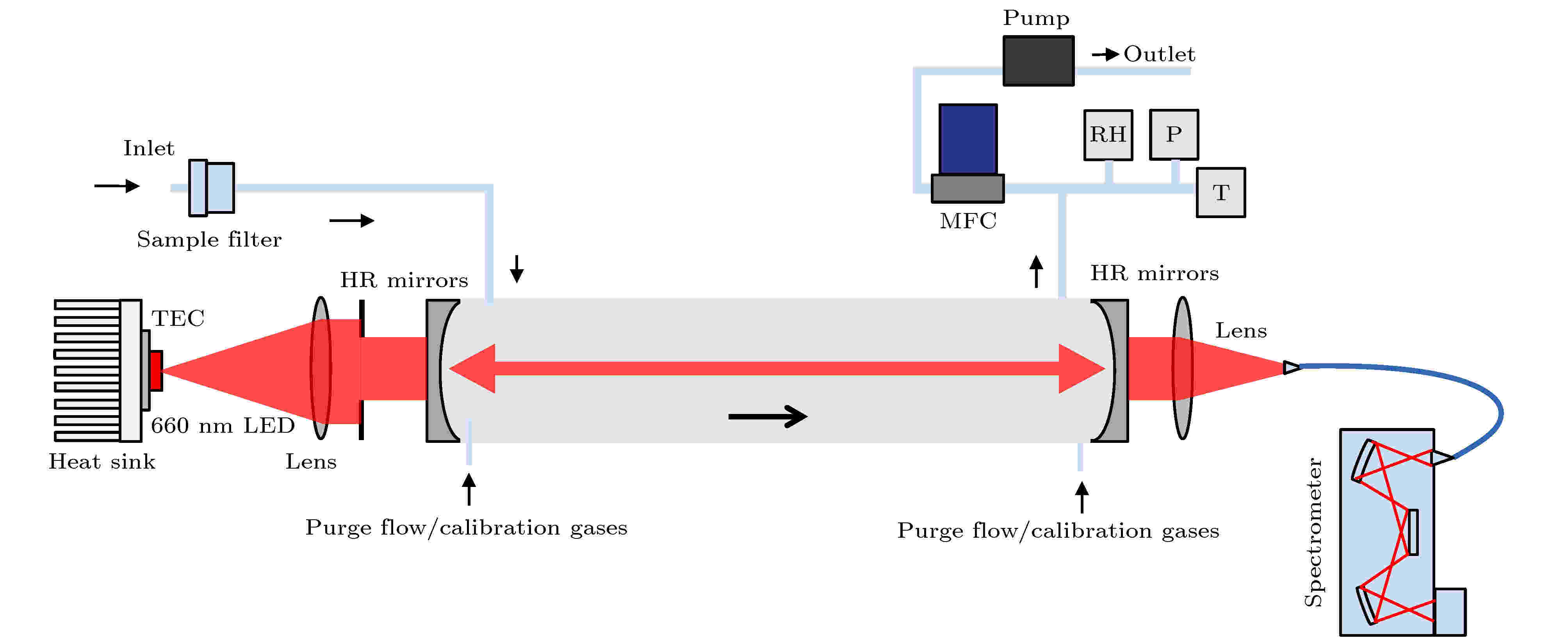
2021, 70 (1): 010702.
doi:10.7498/aps.70.20201066
Abstract +
NO3radical is the most important oxidant in atmospheric chemistry at night, and it controls the oxidation and removal of various trace gas components in the atmosphere. The understanding of the chemical process of NO3radical is of great significance for studying the atmospheric pollution processes such as haze. The NO3radical has a low concentration and strong activity, so it is relatively difficult to measure accurately. We report here in this paper an instrument for unambiguously measuring NO3based on broadband cavity enhanced absorption spectroscopy (BBCEAS). To achieve the robust performance and system stability under diverse conditions, this BBCEAS instrument has been developed, with efficient sampling, and resistance against vibration and temperature change improved, and the BBCEAS instrument also has low-power consumption. The 660-nm-wavelemngth light-emitting diode (LED) is used as a light source of the BBCEAS system. The sampling gas path with low loss and suitable for domestic high-particle environment is designed. Through the LED light source test, the optimal working current and temperature can be obtained to achieve the acquisition of NO3absorption spectrum with high signal-to-noise ratio. Considering the fact that the water vapor absorption is an important interference factor for the measurement of NO3radical by BBCEAS, the daytime atmospheric measurement spectrum is used as a background spectrum, and participates in spectral fitting of NO3to reduce the effect of water vapor. The mirror reflectivity and effective cavity length are calibrated, and the Allan variance analysis is also carried out. The reflectance of the mirror can reach about 0.99993 at 662 nm (NO3absorption peak), and the corresponding theoretical effective optical path can reach more than 7 km, which can meet the measurement requirements of atmospheric NO3radicals. The detection limit (1σ) of 0.75 pptv for NO3is achieved with an acquisition time of 10 s and a total measurement error of about 16%. The atmospheric NO3radical observation is carried out in Hefei. During the observation period, the highest NO3concentration is 23.4 pptv, demonstrating the promising potential applications in in-situ, sensitive, accurate and fast simultaneous measurements of NO3in the future by using the developed broadband cavity enhanced absorption spectroscopy.
NUCLEAR PHYSICS
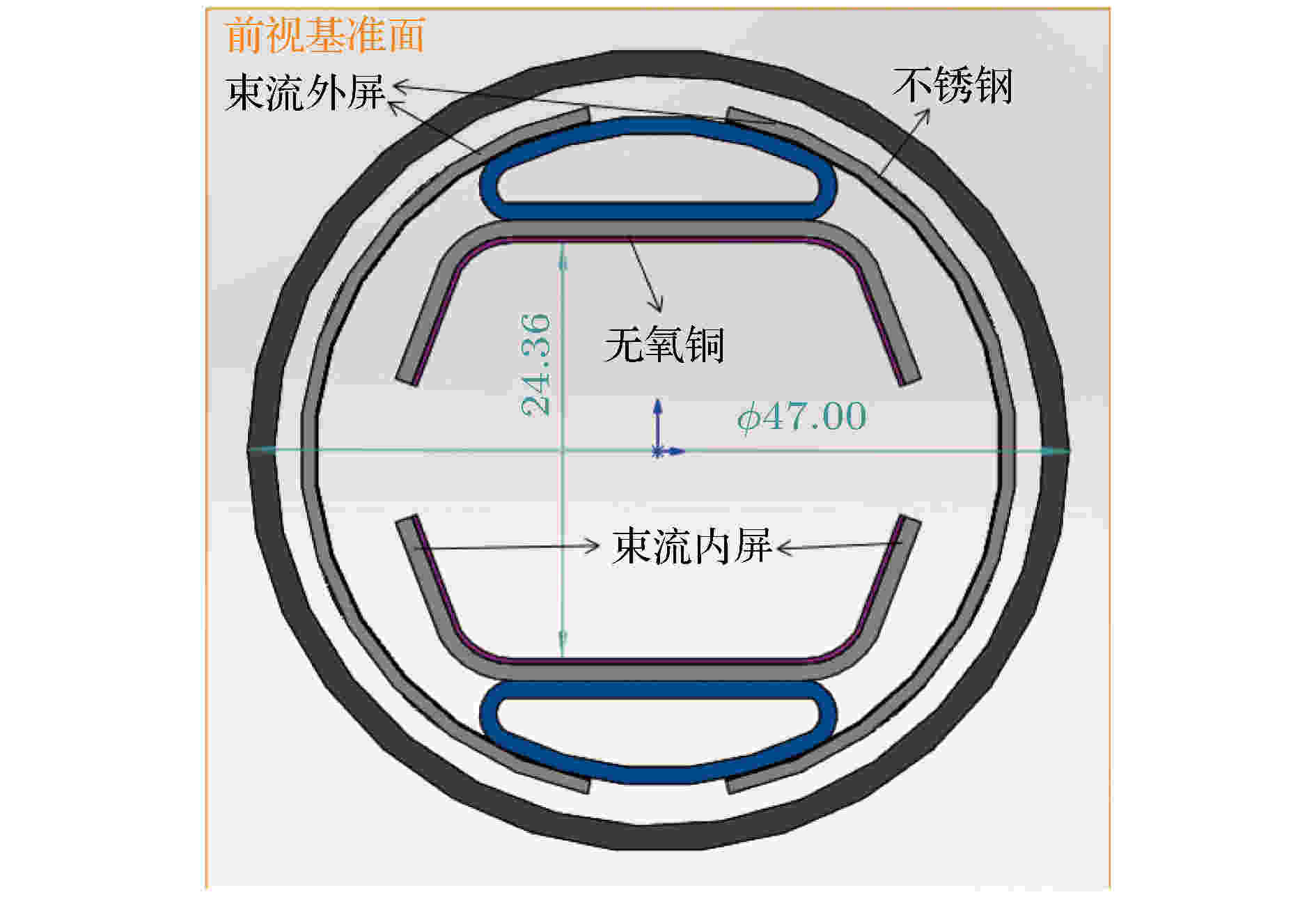
2021, 70 (1): 012901.
doi:10.7498/aps.70.20200830
Abstract +
High-energy colliders play an indispensable role in particle physics and high-energy physics. Beam screen is one of the key parts in the high-energy collider. It is used to transfer the heat generated by the beam in the pipeline to a cooling system, and absorb the residual gas to the cold bore through the pumping holes on the wall of the beam screen to ensure the vacuum stability at the same time. However, in the process of transferring thermal load, the deformation caused by temperature change will affect the structural stability of the beam screen. How to reduce the deformation as much as possible while ensuring the good heat transfer performance of the beam screen is one of the key issues in optimizing the structural design of the beam screen. In this paper, the heat transfer performance and mechanical property of the beam screen model are simulated and optimized based on the ANSYS simulation results to ensure the normal and stable operation of the beam in the super proton-proton collider. For the inner surface of the outer screen of the beam screen, the method of reducing the thickness of the copper coating is used to reduce the Lorentz force generated during operation. The calculation results from the relevant theoretical models show that when the thickness of the copper coating varies from 0 to 100 μm, the copper coating with a thickness of 75 μm can reduce the maximum deformation of the outer screen of the beam screen by 70.9%, while the maximum temperature of the beam screen can be increased by 1.1%. For the inner screen of the beam screen, a design scheme in which supporting ribs are arranged at intervals is used to reinforce the structure and improve the overall structural stability of the beam screen. The calculation results show that the maximum deformation of the inner screen of the beam screen can be reduced by 86.8% and the maximum temperature of the beam screen is reduced by 7.69%, compared with the case without supporting fins, when the interval between two adjacent supporting fins is 1 pumping hole. The research results provide important theoretical reference for the design of beam screen, which is the key component of the vacuum system of the new-generation high energy particle accelerator.
ELECTROMAGNETISM, OPTICS, ACOUSTICS, HEAT TRANSFER, CLASSICAL MECHANICS, AND FLUID DYNAMICS

2021, 70 (1): 014101.
doi:10.7498/aps.70.20201104
Abstract +
Microstrip phased array has aroused interest of many researchers because of its beam agility. However, a big problem for typical microstrip array is that its main beam can only scan from about –50° to 50°, with a gain loss of 4-5 dB. Meanwhile, the relatively narrow operating bandwidth of microstrip antenna is also a problem in application. These flaws have dramatically limited its applications and spawned many studies on phased array with wide-angle scanning capability. Several methods have been proposed to broaden the scanning coverage of phased array, such as utilizing pattern-reconfigurable antenna as an element of array, taking wide-beam antenna as the element of array, and adopt metasurface as the top cladding of array. However, most of existing researches mainly focus on achieving wide-angle scanning performance within a relatively narrow bandwidth. A phased array that possesses wide-angle scanning capability at both main planes within a relatively wide bandwidth is highly desirable. In this paper, a wide-beam magnetoelectric (ME) dipole antenna is proposed. It consists of an ME dipole antenna in the form of microstrip patch and a pair of magnetic dipoles. Metallic through holes integrated with patches and ground are utilized to form magnetic currents. Extra magnetic dipoles are added to broaden the 3-dB beam-width. The simulated results reveal that the 3-dB beam-width of the proposed antenna is greater than 107° in the E-plane (9 GHz–12 GHz) and 178° in the H-plane (7 GHz–12 GHz) respectively. The impedance bandwidth of the proposed antenna is 53.26% from 7.3 GHz to 12.6 GHz (VWSR < 2). Based on the proposed antenna element, two linear phased arrays are fabricated and measured. To test the wide-angle scanning capability of the arrays, each antenna element is simply fed with alternating currents with identical amplitude and linearly increasing phases. The measured results reveal that the wide-angle scanning capability of H-plane array and E-plane array can be obtained from 9 GHz to 12 GHz. The scanning beam of the H-plane array can cover the range from -90° to 90°. The scanning beam of the E-plane array can cover the range from –70° to 70°. The impedance bandwidth of the central antenna is 27.03% for the H-plane array from 9.6 GHz to 12.6 GHz (active VWSR < 2.5) and 36.36% for the E-plane array from 9 GHz to 13 GHz (active VWSR < 2) respectively. Hence, the proposed method can be used as a reference for designing a wide-beam antenna and wide-angle scanning phased array and the designed phased arrays can be applied to X-band radar systems.
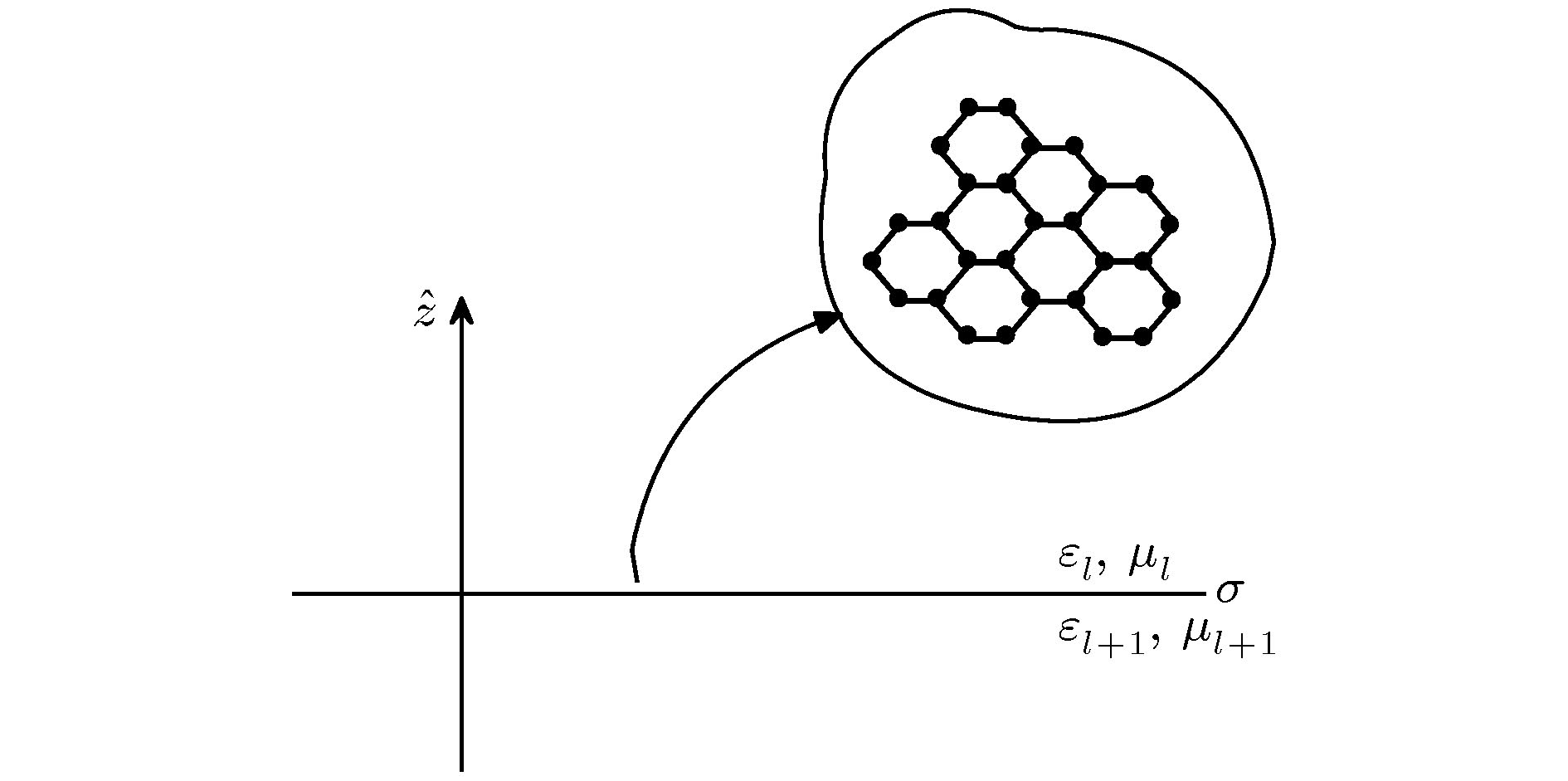
2021, 70 (1): 014102.
doi:10.7498/aps.70.20201089
Abstract +
The reflection and transmission of plane electromagnetic waves on monolayer graphene are studied theoretically in this paper. From an electromagnetic point of view, monolayer graphene is described as an “infinitely thin” graphene sheet characterized by a surface conductivity, and based on a microscopic quantum dynamical approach, the graphene sheet becomes anisotropic in the presence of both an electrostatic and a magnetic bias. In this work, starting from boundary conditions and phase-matching conditions, the propagation matrix for the analysis of the interaction between an electromagnetic field and thin graphene sheet which is biased electrostatically and magnetostatically, and then characterized by an anisotropic conductivity, is derived. Furthermore, the analytical solutions of co- and cross-polarization reflective and transmittance coefficients through an anisotropic graphene planar surface are obtained from the proposal matrix above, which couples the fundamental transverse electric (TE) polarization and transverse magnetic (TM) polarization and includes the possible effects of electrostatic and/or magnetostatic bias. In conclusion, the cross-polarization reflective coefficient of TE wave and that of TM wave are equal, and their cross-polarization transmittance coefficients have opposite phase. Finally, a new propagation matrix for stratified medium containing anisotropic graphene interfaces is deduced by embedding the matrix across graphene sheet mentioned above into the traditional propagation matrix for isotropic stratified medium. The proposed new matrix can be used to investigate the propagation properties of plane wave in a complex structure of layered medium and anisotropic conductivity interfaces (including graphene sheet) analytically and quickly, and represents a very simple tool for the relevant analysis and design.

2021, 70 (1): 014201.
doi:10.7498/aps.70.20201017
Abstract +
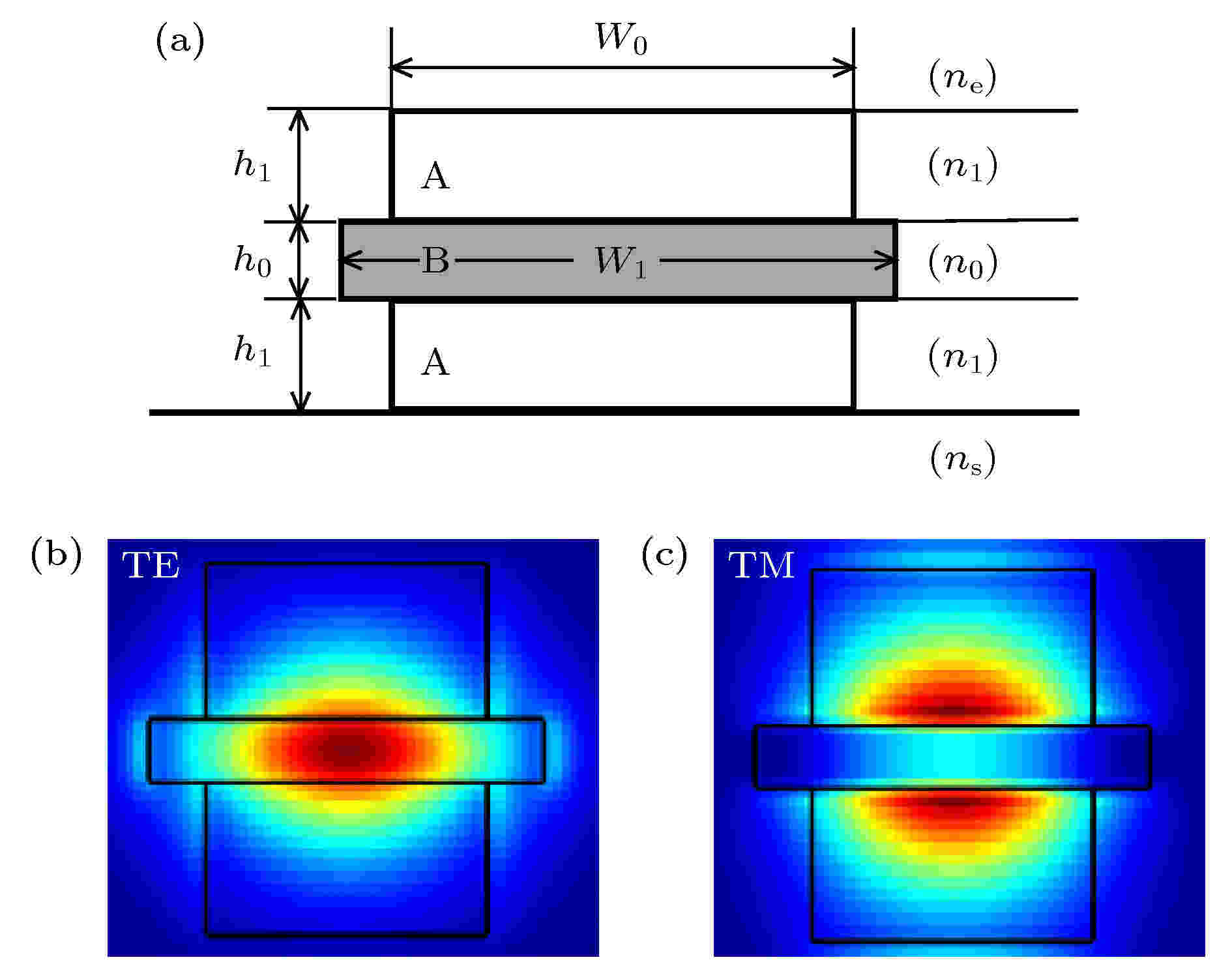
2021, 70 (1): 014202.
doi:10.7498/aps.70.20200721
Abstract +
An ultra-compact 1×2 demultiplexer based on directional coupler (DC) waveguide is proposed to separate the 1310 nm wavelength from 1550 nm wavelength, in which a new Si3N4/SiNx/Si3N4sandwiched structure is used to realize polarization insensitivity. Firstly, the new sandwiched structure is designed to be polarization-independent. The coupling lengths of two orthogonal polarization modes at the same wavelength versus the gap between two parallel SiNxwaveguidesg1are calculated with several groups of structure parameters of the demultiplexer. The result shows that the coupling lengths for the two orthogonal polarization modes at the same wavelength can be identical by choosing the properg1. Then, how to realize the function of wavelength separation is studied. When one wavelength propagates at even multiple of coupling length and the other wavelength propagates at odd multiple of coupling length, and vice versa, the two working wavelengths will output from different output ports, thereby the two wavelengths are successfully separated. Under the premise of satisfying such conditions, a comparison of size and performance among the devices with different groups of structure parameters is given to find the best one. The demultiplexer based on Si3N4/SiO2platform has a compact structure, easy integration and good tolerance. Three-dimensional(3D) finite-difference time-domain method is used for simulation, and the results show that the length of the DC waveguide is only 23 μm; the insertion loss and crosstalk are as low as 0.1 dB and–26.23 dB respectively; a broad 3-dB bandwidth of 200 nm is achieved. To demonstrate the transmission characteristics of the demultiplexer, the evolution of the excited fundamental mode in the demultiplexer is also given. The novel demultiplexer is polarization-independent and can work at 1310 nm and 1550 nm wavelengths simultaneously. It has a potential application value in future integrated optical circuits.
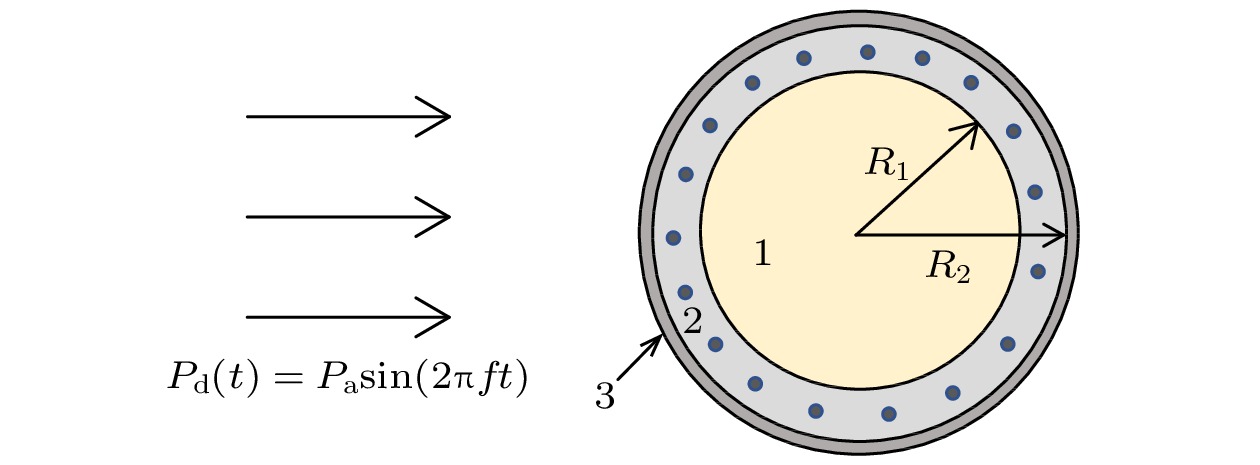
2021, 70 (1): 014301.
doi:10.7498/aps.70.20200973
Abstract +
The combination of superparamagnetic iron oxide nanoparticles (SPIOs) with ultrasonic contrast agent (UCA) microbubble is called magnetic microbubble (MMB) and has been used to produce multimodal contrast agents to enhance medical ultrasound and magnetic resonance imaging. The nanoparticles are either covalently linked to the shell or physically entrapped into the shell. Considering the effect of the volume fraction of SPIOs on the shell density and viscosity, a nonlinear dynamic equation of magnetic microbubbles (MMBs) with multilayer membrane structure is constructed based on the basic theory of bubble dynamics. The influences of the driving sound pressure and frequency, particle volume fraction, shell thickness and surface tension on the acoustic-dynamics behavior of microbubbles are numerically analyzed. The results show that when the volume fraction of magnetic particles is small andα≤ 0.1, the acoustic properties of magnetic microbubbles are similar to those of ordinary UCA microbubbles. The acoustic response of the microbubble depends on its initial size and driving pressure. The critical sound pressure of microbubble vibration instability is lowest when the driving sound field frequency is twice the magnetic microbubble resonance frequencyf0(f= 2f0). The presence of magnetic particles inhibits the bubbles from expanding and contracting, but the inhibition effect is very limited. The surface tension parameterKof the outer film material and thickness of the shell also affect the vibration of the microbubble. WhenKand film thickness are 0.2–0.4 N/m and 50–150 nm respectively, it is observed that the bubble has an unstable vibration response region.
PHYSICS OF GASES, PLASMAS, AND ELECTRIC DISCHARGES
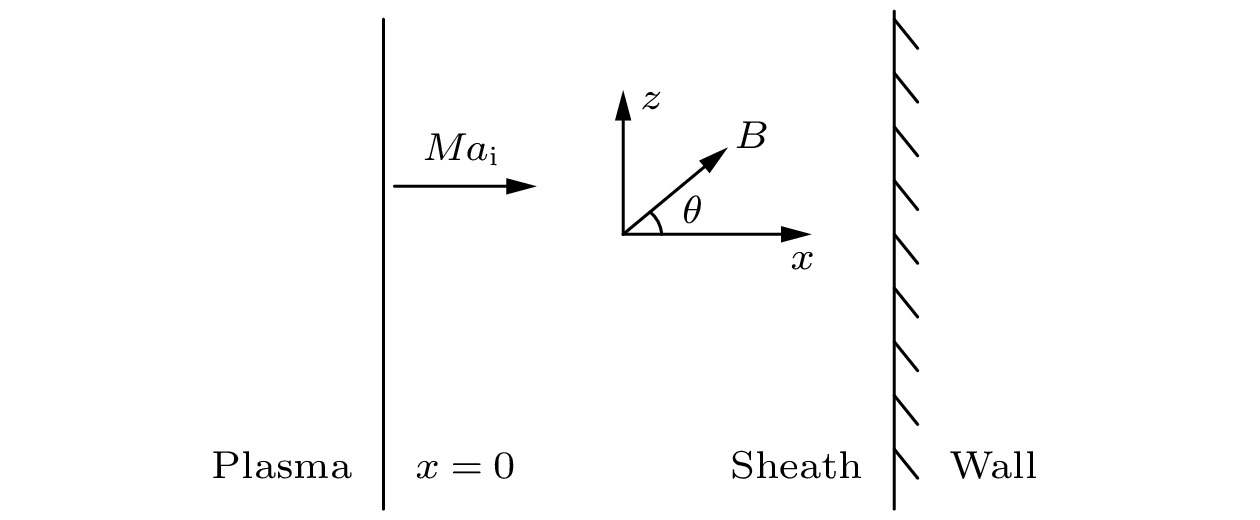
2021, 70 (1): 015201.
doi:10.7498/aps.70.20200794
Abstract +
Many previous researches on the plasma sheath were based on the fact that the electrons satisfy the classical Maxwell velocity distribution function, while the particles in the plasma have long-range electromagnetic interactions. It is more appropriate to use the non-extensive distribution proposed by Tsallis to describe the electrons. In this paper, a collisional magnetized plasma sheath model with non-extensive distribution of electrons is established. Bohm criterion is derived theoretically. With the ion drift motion in the plasma pre-sheath region taken into consideration, the ion Mach number is only related to the angle of the magnetic field, the collision parameters, the electric field at the sheath edge, and non-extensive parameter
$ q $
. The influence of parameter
$ q $
on the criterion is discussed in this paper. The lower limit of the ion Mach number changes with the value of parameter
$ q $
. The lower limit of the ion Mach number increases for
$ q < 1 $
. And the lower limit of the ion Mach number decreases for
$ q>1 $
. With the increase of
$ q $
, the number of electrons with lower speed increases, ions need less kinetic energy to enter into the sheath and thus enter into the sheath more easily. Through numerical simulation, it is found that compared with the structure of the plasma magnetized sheath with Maxwell distribution (
$ q=1 $
), the structure of the plasma magnetized sheath with super-extensive distribution (
$ q < 1 $
) and that with sub-extensive (
$ q>1 $
) are different, including the distribution of the space potential, the ion density, the electron density, and the space charge density. When
$ q < 1 $
, the space potential, the electron density and the ion density fall more slowly, and the peak of the space charge density curve is closer to the wall. When
$ q>1 $
, the space potential and the ion electron density fall faster, especially the electron density drops to zero faster, and the peak of the space charge density curve is far away from the wall. The simulation results show that the non-extensive parameter
$ q $
has a significant influence on the structure of collisional plasma magnetized sheath. The influence of the collision on the magnetized plasma sheath with non-extensive distribution is similar to that with the Maxwell distribution. These conclusions may be useful in solving the problems of plasma boundary.
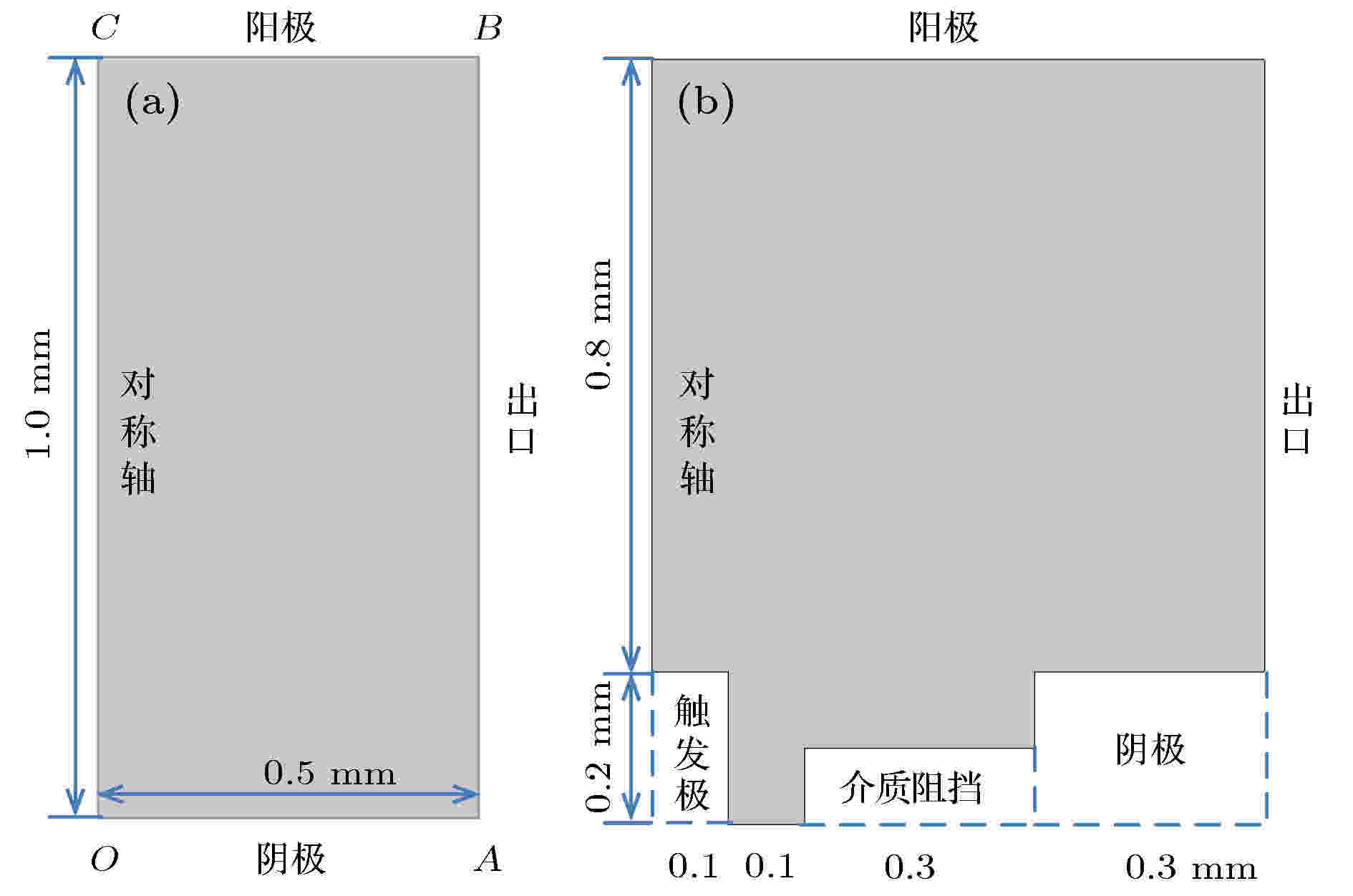
2021, 70 (1): 015202.
doi:10.7498/aps.70.20201206
Abstract +
Compared with the two-electrode gas spark switch, the three-electrode gas spark switch has high controllability, low working voltage and small jitter, so the three-electrode gas spark switch is widely used in pulse power technology. The discharge of gas spark switch is high pressure gas discharge, which is characterized by high electron collision frequency (1012Hz), small mean free path (10–6m), short breakdown time (10–9s), and complex physical process (including the secondary electron emission, the generation of seed electrons, the space charge effect and various collision processes between electrons and nitrogen molecules, etc). At present, it is difficult to quantitatively describe the breakdown process of the three-electrode gas switch, and the detailed theoretical research is lacking. Therefore, the breakdown mechanism of atmospheric pressure nitrogen spark switch, including two-electrode and three-electrode, is studied theoretically and numerically in this paper. The purpose of this study is to compare the simulation results of the two different gas spark switches, and obtain the characteristics of stream breakdown in different gas spark switches. Firstly, the numerical simulation and theoretical analysis of two-electrode gas spark switch are carried out. According to theoretical and numerical calculation, it can be found that for the plate-plate two-electrode switch, the stream breakdown cannot be generated under low voltage (less than 6.3 kV), while under high voltage (more than 6.3 kV), first the anode-directed streamer is formed, and then the cathode-directed streamer is created. In addition, the simulation results show that the plasma generated by the trigger can effectively reduce the breakdown voltage. Finally, the three-electrode gas spark switch is studied theoretically and numerically. It can be seen that in the breakdown process of the three-electrode gas spark switch, the breakdown first occurs between the trigger and the insulator, and then this plasma channel expands to the anode and cathode, finally forming the arc channel between the anode and the cathode. Under the calculation conditions in this paper, if the cathode-trigger and the anode-trigger are required to break down simultaneously, the applied voltage between the cathode-trigger should be greater than 1.18 kV, while the applied voltage between the anode-trigger should be greater than 3 KV. When the field emission of the trigger is considered, the breakdown threshold can be significantly reduced.
CONDENSED MATTER: STRUCTURAL, MECHANICAL, AND THERMAL PROPERTIES
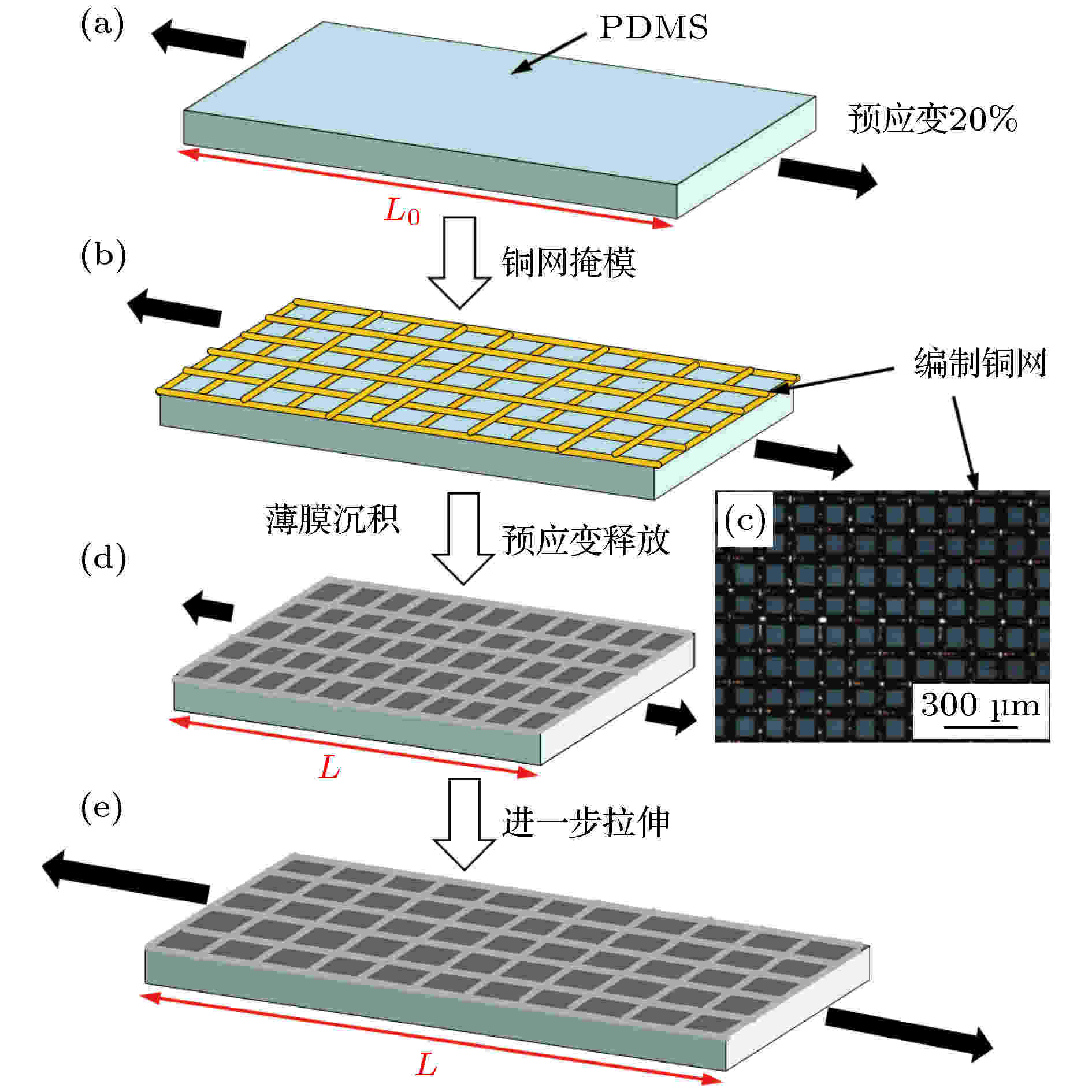
2021, 70 (1): 016801.
doi:10.7498/aps.70.20201008
Abstract +
Controlled surface structures have important applications in the fields of flexible electronics, bionic devices, smart materials and surface engineering. Although various instability modes induced by stresses in homogeneous and heterogeneous film systems have been investigated extensively in the past decades, understanding the stress relief mechanisms of gradient film systems is still a challenge. In this work, periodic thickness-gradient metal silver films on flexible polydimethylsiloxane (PDMS) substrates are prepared by using magnetron sputtering technique and by masking weaved copper grid during deposition. The morphological evolutions and structural characteristics of the gradient films in the uniaxial mechanical compression/tension process are detected by using optical microscopy and atomic force microscopy. It is found that the thickness-gradient film spontaneously forms on the PDMS surface due to the specific three-dimensional structure of the weaved copper grid. The maximum film thickness in the mesh center is about twice larger than the minimum one in the region covered by the copper wire. Under the uniaxial mechanical loading, the silver film surface will form stripe wrinkles and straight cracks, which are aligned perpendicular to each other. The variation of film thickness can well modulate the in-plane strain distribution of the film and thus the stress relief patterns. As the compressive strain increases, the wrinkles first form in the region with smaller film thickness, and then extend into the region with larger thickness. The wrinkle wavelength decreases with compressive strain increasing, which is in consistent with the theoretical prediction of accordion model. The wavelength and amplitude of the wrinkles exhibit periodically oscillatory behaviors across the film surface. As the tensile strain increases, the cracks start to propagate in the region with smaller thickness, and then the crack width and number both increase gradually, leading the multiple crack modes to form finally. The crack width and average spacing both increase with film thickness increasing. The morphologies and evolutions of such wrinkles and cracks in the thickness-gradient films are analyzed in depth based on the stress theory. The wrinkle patterns are further simulated by the finite element method, and the simulation results are in good agreement with the experimental results. This study could promote a better understanding of the strain effects of heterogeneous film systems and find the applications in the field of flexible electronics by the structural design of thickness-gradient films.
CONDENSED MATTER: ELECTRONIC STRUCTURE, ELECTRICAL, MAGNETIC, AND OPTICAL PROPERTIES
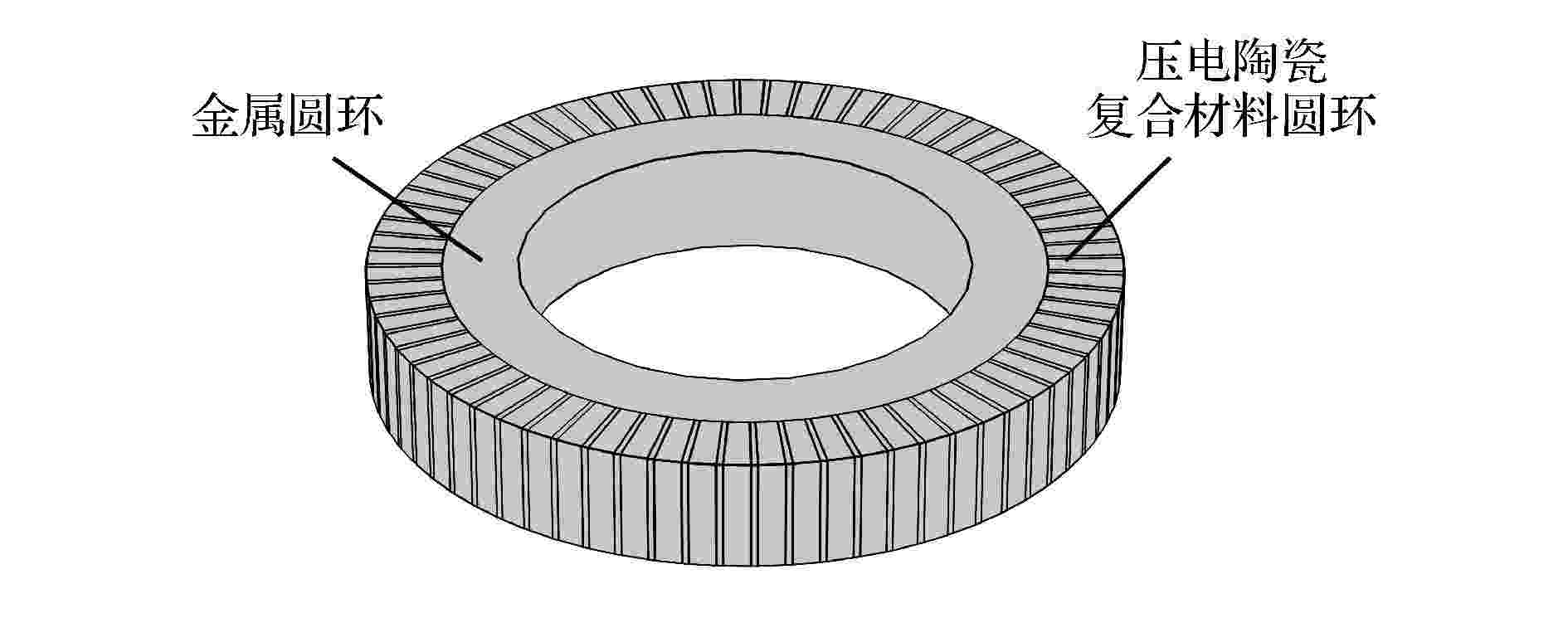
A new broadband radial vibration ultrasonic transducer based on 2-2 piezoelectric composite material
2021, 70 (1): 017701.
doi:10.7498/aps.70.20201352
Abstract +
Radial vibration transducer has the advantages of large radiation area, high radiation efficiency, uniform radial radiation, and wide range of action. Therefore, it is widely used in the technical fields of ultrasonic liquid treatment such as underwater acoustics, ultrasonic degradation and sonochemistry. On the other hand, the 2-2 piezoelectric composite material is one of the most commonly researched piezoelectric composite materials with the best development prospects. Compared with traditional pure piezoelectric ceramics, this new type of material has the advantages of low impedance, low mechanical quality factor, and frequency bandwidth. Therefore, in this paper we propose a new broadband radial vibration ultrasonic transducer based on 2-2 piezoelectric composite material, which is mainly composed of an inner metal ring and an outer piezoelectric ceramic composite ring. First, the Newnham series-parallel theory and the uniform field theory are used to derive the equivalent parameters of the 2-2 piezoelectric composite material. Second, the radial vibration of the combination of the metal ring and the radially polarized piezoelectric composite ceramic ring are analyzed by the analytical method. The six-terminal electromechanical equivalent circuit of the transducer is obtained, and the frequency equation of the transducer is also obtained. And then the relationship between the resonant frequency and anti-resonant frequency of the transducer, as well as the effective electromechanical coupling coefficient, geometric size, and two-phase volume ratio are analyzed. It is concluded that in order to obtain higher electromechanical conversion efficiency, the design of the transducer radius ratio should be as close as possible to 0.35. Although the higher proportion of polymer phase will lead the electromechanical conversion efficiency to decrease, it can also bring better acoustic matching ability. Therefore, the lower proportion of polymer phase can be selected in the transducer design. The finite element method is used to numerically simulate the radial vibration of the new transducer. The results show that the resonance frequency and anti-resonance frequency obtained by the analytical method are in good agreement with the numerical simulation results. In addition, the acoustic field of the transducer under water is simulated numerically. The results show that compared with the traditional pure ceramic radial transducer, the new composite radial transducer has a large emission voltage response amplitude, the working bandwidth is nearly doubled, and the acoustic matching is better.
INTERDISCIPLINARY PHYSICS AND RELATED AREAS OF SCIENCE AND TECHNOLOGY
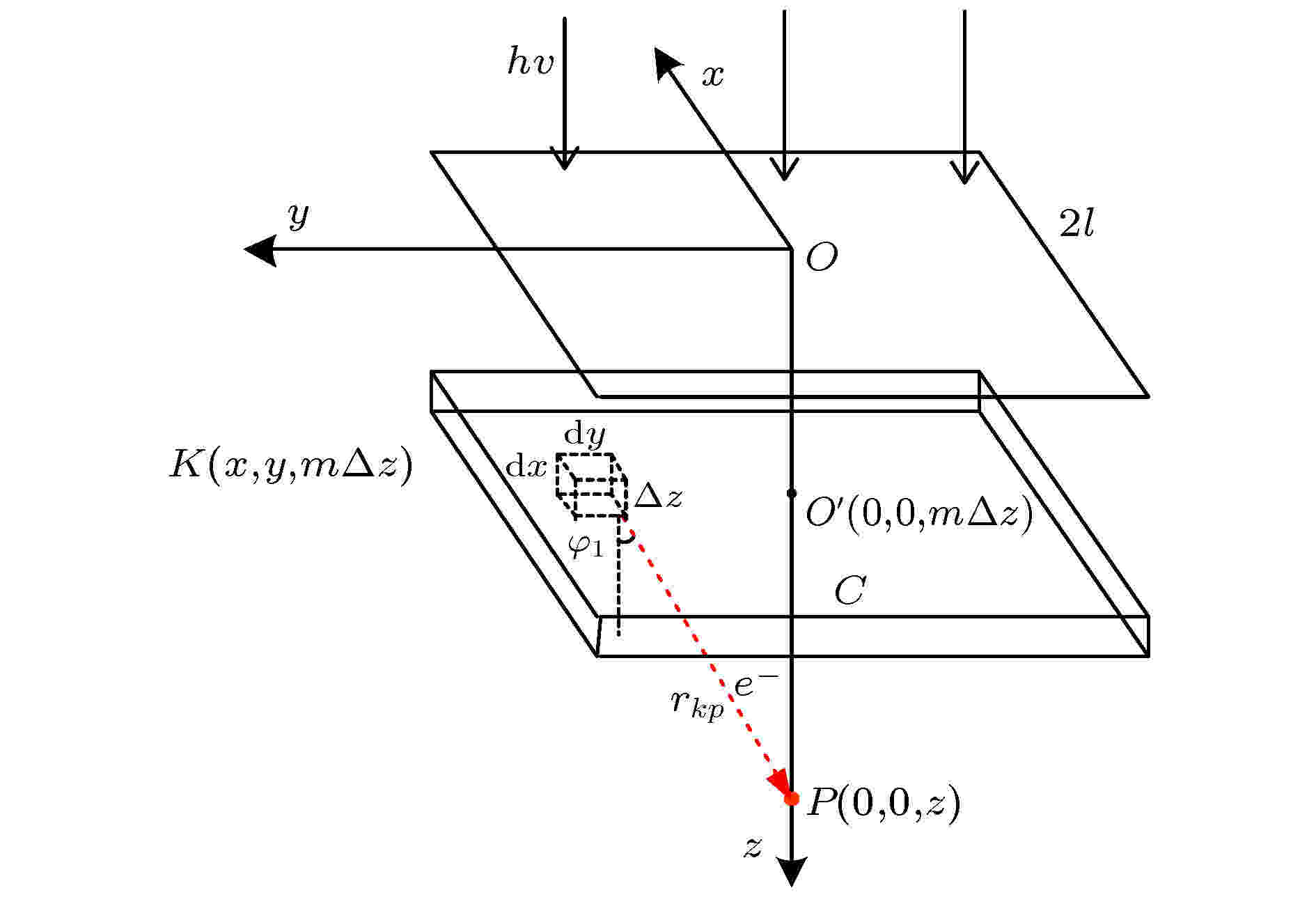
2021, 70 (1): 018701.
doi:10.7498/aps.70.20200986
Abstract +
A algorithm of obtaining absolute dose at each tissue depth only by the mathematical calculation of formula is reported. The algorithm is based on integrating the energy flux of the electron generated by X-ray in the range of irradiation field, and the energy spectrum of ray and the secondary scattered ray are considered in this process. In this algorithm, the water phantom in the irradiation field is divided into several thin layers, and the energy flux of the electrons generated by interaction between the ray and thin layer reaching the calculation point is calculated. Finally, the absolute dose of the calculation point can be obtained by accumulating the energy flux contribution of all thin layers. For the X-ray with continuous energy spectrum, the expected mass attenuation coefficient is calculated for obtaining the photon flux at each depth in this process. The absolute dose calculated by this algorithm is verified by Monte Carlo simulation, and the difference between the algorithm and simulation is compensated for by a dose function about multiple scattering photons, and the function shows fast descent and then slow ascent. It is found that the ratio of the dose caused by backscatter to the surface dose, and the relationship among forward scatter, backward scatter and primary ray, and the relationship between the dose and the depth of the secondary scattered rays show a trend of first rising and then declining, and the depth of the peak value deviates from the position of the thin layer. Three-dimensional energy spectra of the secondary photon and the secondary electron are also compared with each other, and the spectrum is a function of particle flux about particle energy and particle direction. From the perspective of Compton effect, the physical meanings of different positions in the three-dimensional energy spectrum of the two particles are explained. It is found that the difference between algorithm percentage depth dose and simulation percentage depth dose is similar to the difference between small irradiation field percentage depth dose and big irradiation field percentage depth dose from simulation, and it is verified that the difference between algorithm and simulation comes from the increase of scattered rays. Finally, the algorithm is applied to the dose calculation of non-uniform phantom, which can accurately reflect the dose distribution characteristics and have less error.
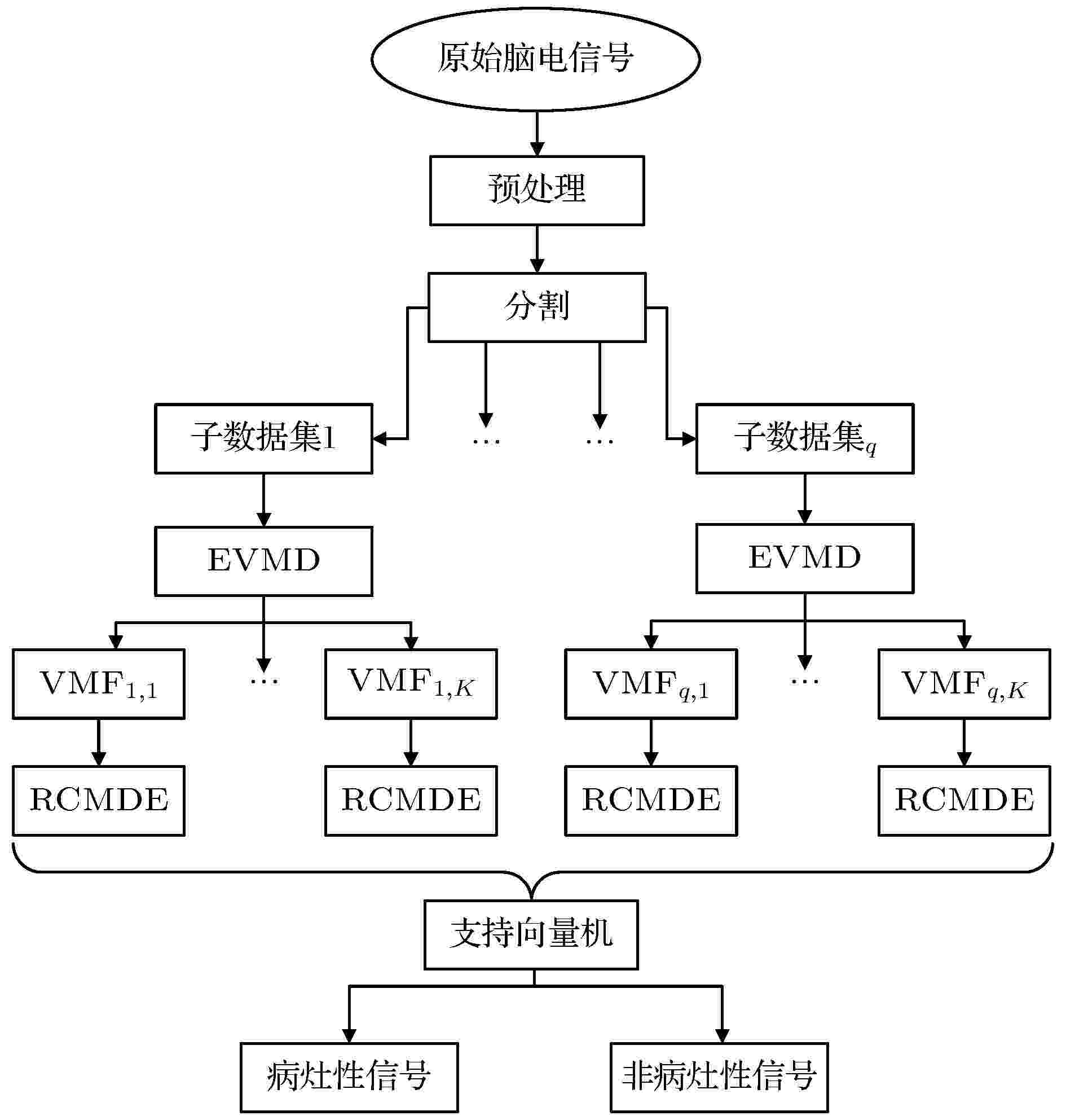
2021, 70 (1): 018702.
doi:10.7498/aps.70.20200904
Abstract +
Epilepsy is an extensive nervous system disease nowadays. Electroencephalogram (EEG) can capture the abnormal discharge of nerves in the brain duration of seizure and provide a non-invasive way to identify epileptogenic sites in the brain. In order to distinguish between focal epilepsy EEG signal and non-focal epilepsy EEG signal, in this paper we propose an automated epileptic EEG detection method based on the elastic variational mode decomposition (EVMD). The proposed EVMD algorithm is a method of analyzing the signals and also a processing method in time-frequency domain, in which the elastic net regression is used to reconstruct a constrained variational model in variational mode decomposition (VMD). Used in the VMD algorithm is the Tikhonov regularization that is also statistically called ridge regression as a solution of recovering the unknown signal and assessing the bandwidth of a mode, namely the variational equation constructed by VMD only has L2 norm. However, the ridge regression cannot select variables when the equation has multiple variables. Another regression method, called lasso regression, only has L1 norm and can select a more accurate model from multiple variables, but it has worse performance when variables have group effect or co-linearity. The elastic net regression has advantages of ridge regression and lasso regression, in other word, the variational equation constructed by EVMD has both L1 regularization item and L2 regularization item, so in this paper we propose the EVMD by elastic net regression. In addition, in this paper the EVMD is used to distinguish between focal epilepsy EEG signal and non-focal epilepsy EEG signal. Firstly, the original EEG signals are divided into several sub-signals where the test signals are divided into sub-signals with shorter durations by time series and a reasonable time overlap is kept between successive sub-signals. After that each sub-signal is decomposed into intrinsic mode functions by using the EVMD. Furthermore, the refined composite multiscale dispersion entropy (RCMDE) as feature is extracted from each intrinsic mode function where a Student’s t-test is used to assess the statistical differences between RCMDEs extracted from focal and non-focal EEG signals respectively. Finally, the support vector machine (SVM) is used to classify their features. For an epilepsy EEG signalspublic data set, the final experimental results show that the performance indices of accuracy, sensitivity, and specificity can reach 92.54%, 93.22% and 91.86% respectively.
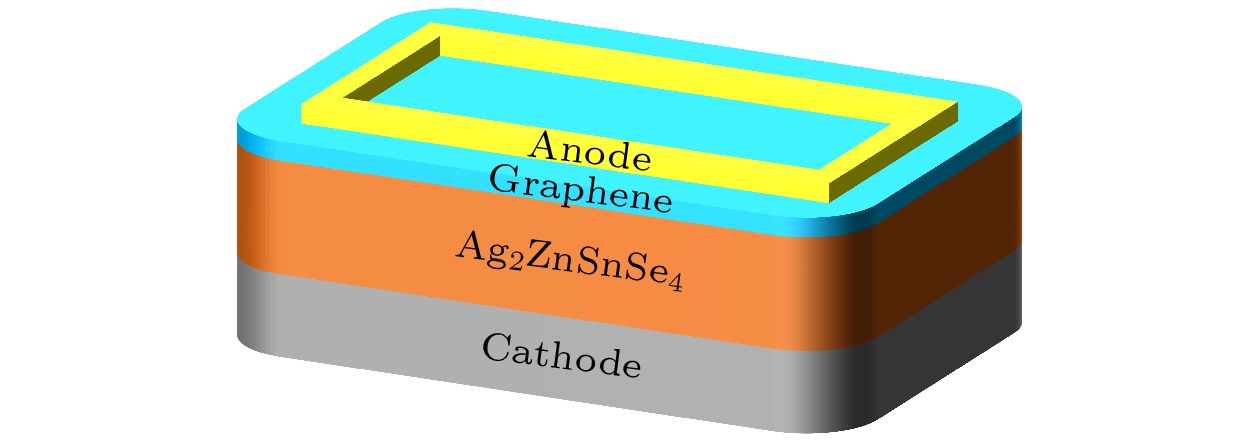
EDITOR'S SUGGESTION
2021, 70 (1): 018801.
doi:10.7498/aps.70.20201194
Abstract +
Ag2ZnSnSe4is an n-type semiconductor with a suitable bandgap of 1.4 eV. In the present study, a graphene/Ag2ZnSnSe4induced p-n junction thin film solar cell is proposed and the physical mechanism and performance influencing factors of the solar cell are simulated and analyzed by using the wxAMPS software. The simulation results show that when a high work function graphene contacts an n-type Ag2ZnSnSe4semiconductor, the energy band of the Ag2ZnSnSe4absorber layer bends upward, meanwhile a p-type Ag2ZnSnSe4inversion layer is induced on the surface of n-type Ag2ZnSnSe4, therefore the p-type Ag2ZnSnSe4and n-type Ag2ZnSnSe4form an induced p-n homojunction. It is found that the work function of graphene and back contact significantly influence the photogenerated carrier separation, transportation and collection. The graphene work function should be 5.5 eV and the work function of back contact should not be greater than 4.4 eV, which is beneficial to the improving of the device performance. The doping concentration of Ag2ZnSnSe4absorber mainly affects the short-circuit current of the device, however, the defect density of Ag2ZnSnSe4absorber affects the whole device performance. When the work function of graphene and back contact are 5.5 eV and 3.8 eV, the doping concentration and defect density of Ag2ZnSnSe4absorber are 1016cm–3and 1014cm–33, respectively, the conversion efficiency of the graphene/Ag2ZnSnSe4induced p-n junction thin film solar cell can reach 23.42%. These simulation results provide the idea and physical explanation for designing a novel type of solar cell with high efficiency and low cost.
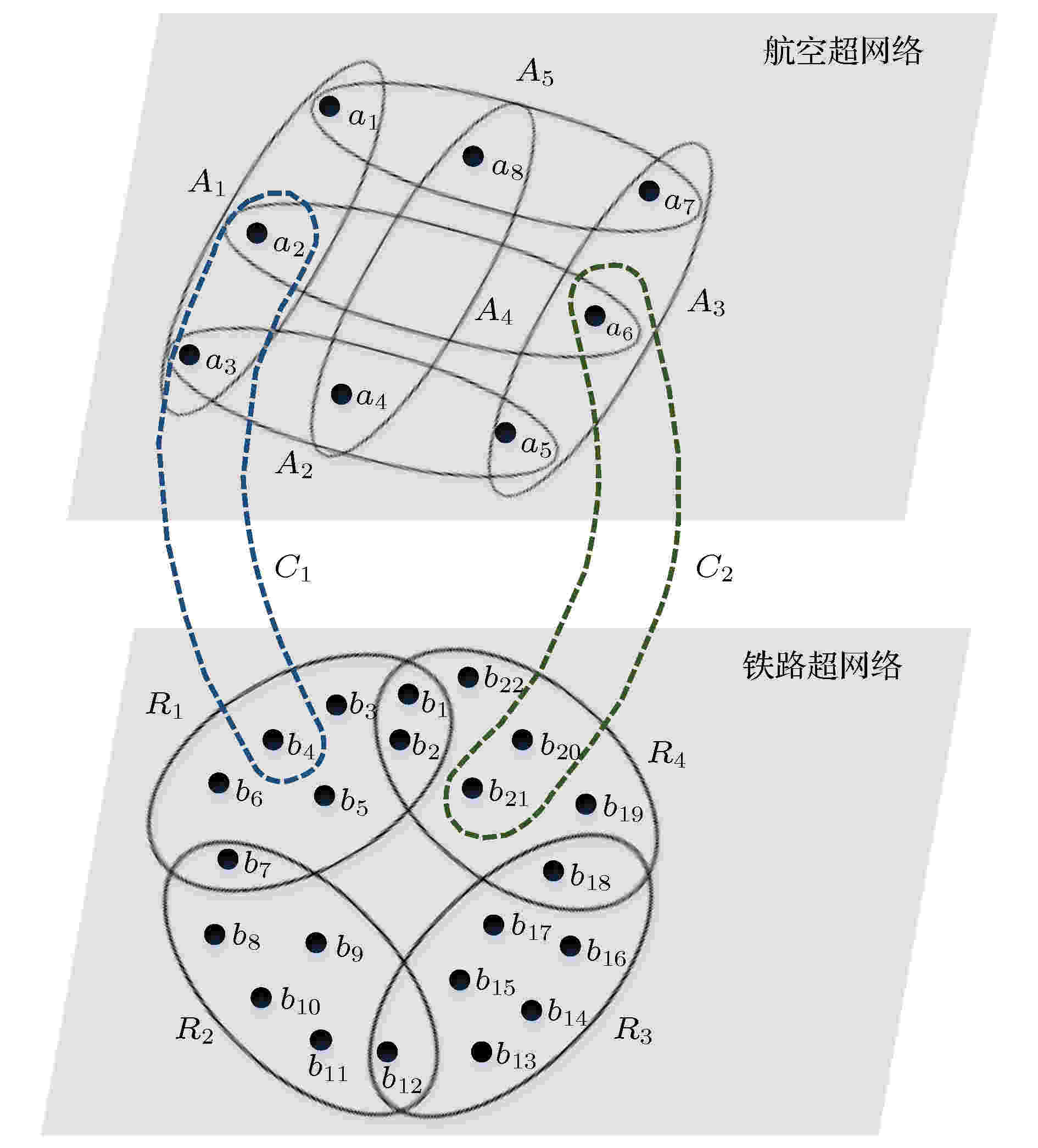
2021, 70 (1): 018901.
doi:10.7498/aps.70.20201065
Abstract +
With the rapid development of social economy, the relationship between social members and groups has shown more complex and diverse characteristics. As a network depicting complex relation and multi-layer, hyper network has been widely used in different fields. Random network that obeys Poisson distribution is one of the pioneering models studying complex networks. In the existing hyper network researches, the hyper network based on ER random graph is still a blank. In this paper, we first propose an ER random hyper network model which is based on the hypergraph structure and it adopts the ER random graph theory. Furthermore, using this model, the node hyper degree distribution of this hyper network model is analyzed theoretically, and the node hyper degree distribution is simulated under different hyper edge probabilities:
$ p=0.004$
,
$ p=0.006$
,
$ p=0.008$
and
$ p=0.01$
. The results show that the node hyper degree distribution of this hyper network model complies to the Poisson distribution
$p(k)\approx \dfrac{{{\left\langle \lambda \right\rangle }^{k}}}{k!}{{e}^{-\left\langle \lambda \right\rangle }}$
, which conforms with the characteristics of random networks and is consistent with the theoretical derivation. Further, in order to more accurately and effectively describe the multiple heterogeneous relationship in real life, in this paper we construct three different kinds of double-layer hyper network models with node hyper degree distribution with bimodal peak characteristics. The three kinds respectively are ER-ER, BA-BA and BA-ER, where ER represents the ER random hyper network, and BA denotes the scale-free hyper network, and the layers are connected by a random manner. The analytical expressions of node hyper degree distribution of the three kinds of double-layer hyper network models are obtained by theoretical analysis, and the average node hyper degrees of the three double-layer hyper networks are closely related to the inter-layer hyper edge probability. As the inter-layer hyper edge probability increases, the average node hyper degree increases. The results of simulation experiments show that the node hyper degree distributions of three kinds of double-layer hyper network models proposed in this paper possess the characteristics of bimodal peaks. The ER random hyper network model and the double-layer hyper network model proposed in this paper provide the theories for further studying the hyper network entropy, hyper network dynamics, hyper network representation learning, hyper network link prediction, and traffic hyper network optimization of such hyper networks in the future, and also it has certain reference significance for studying the evolution of multilayer hyper networks.





















